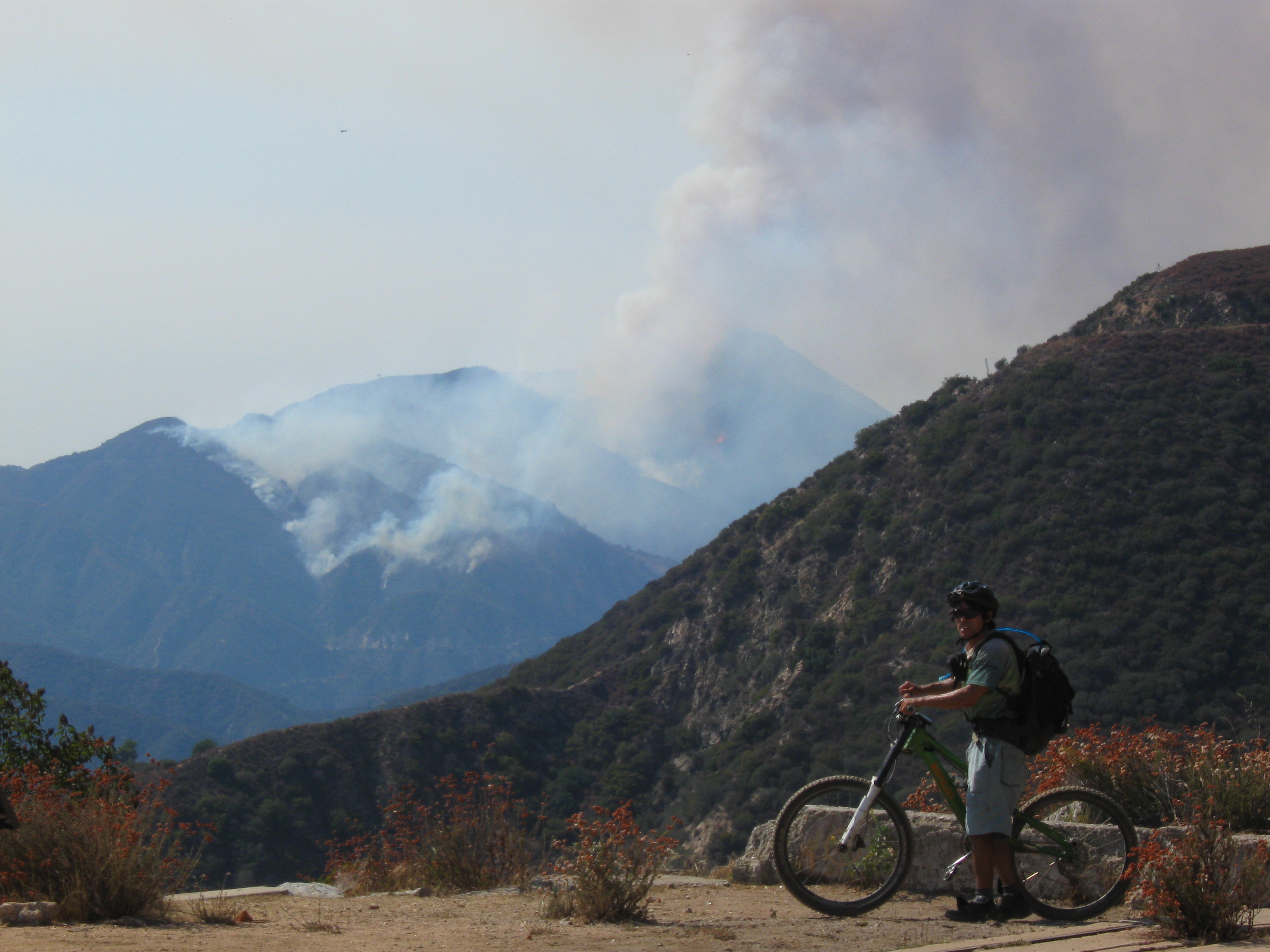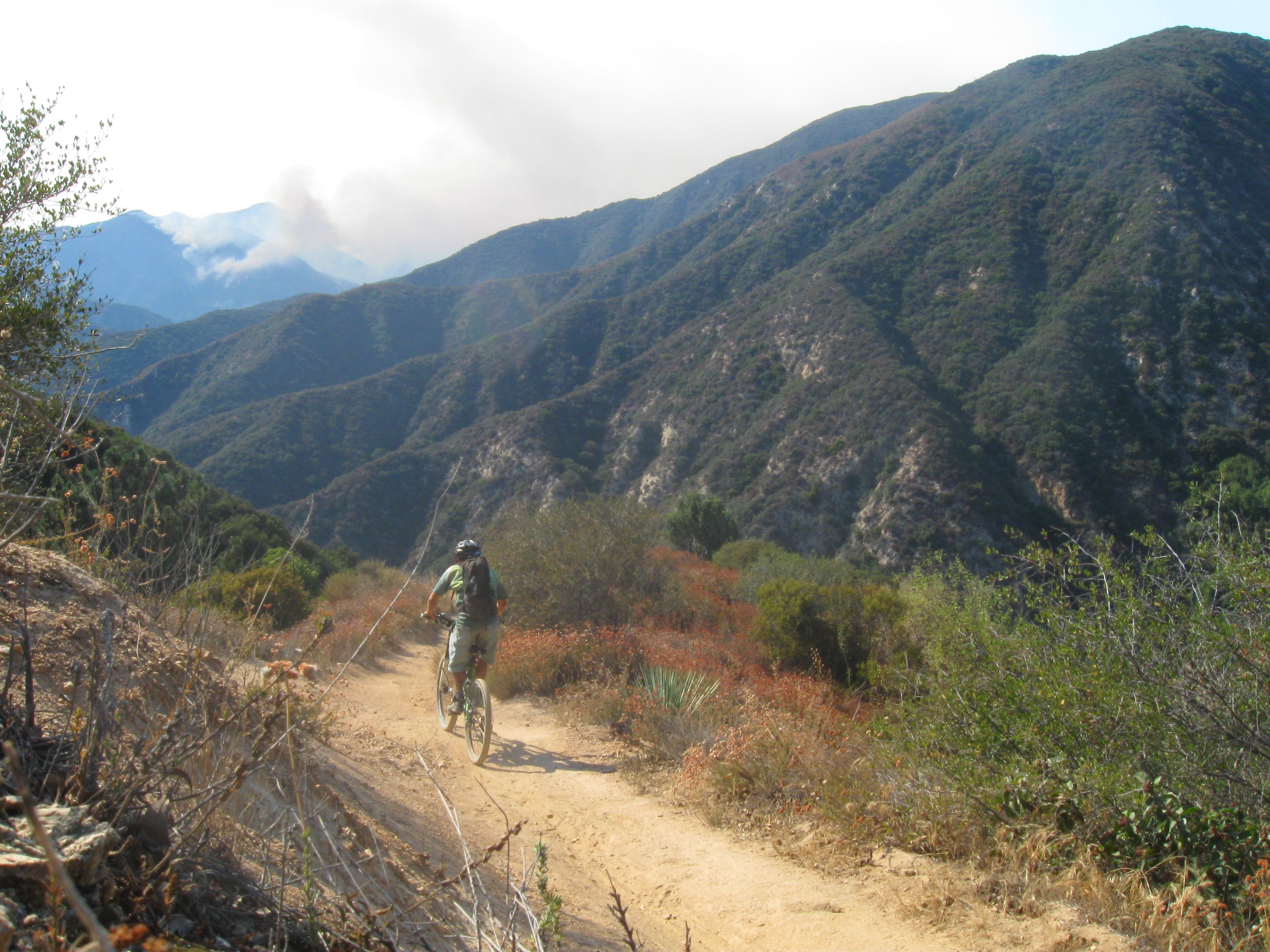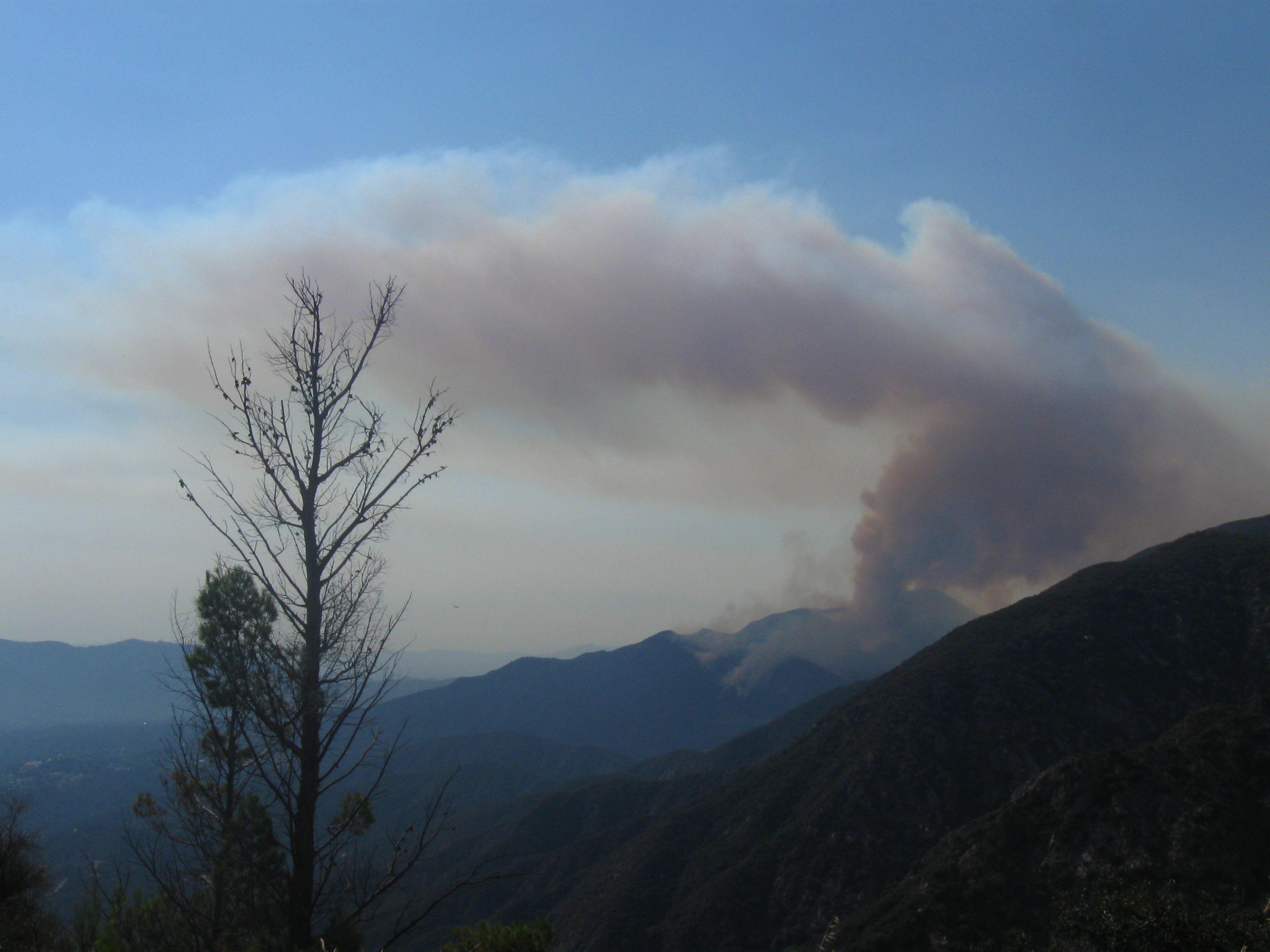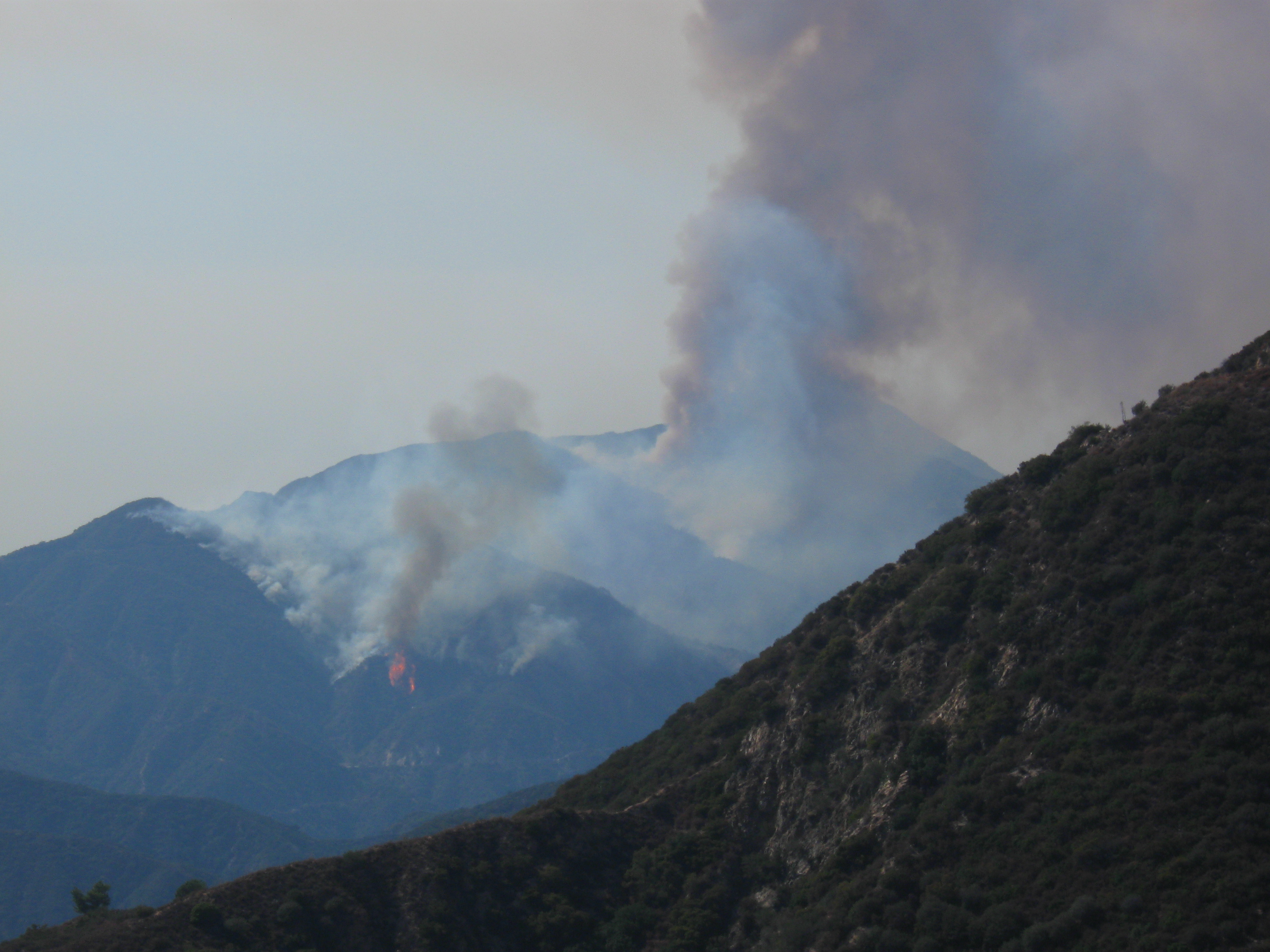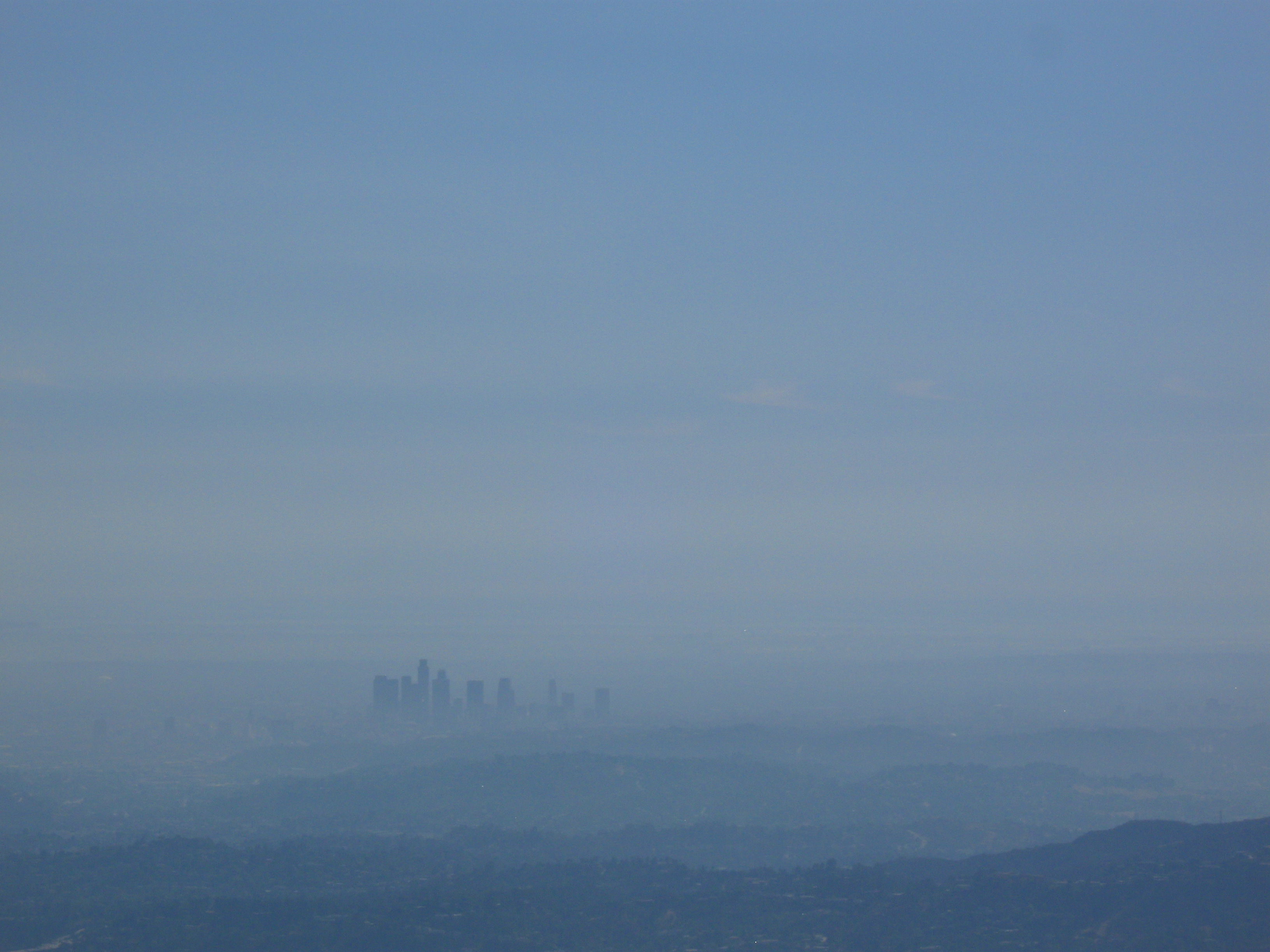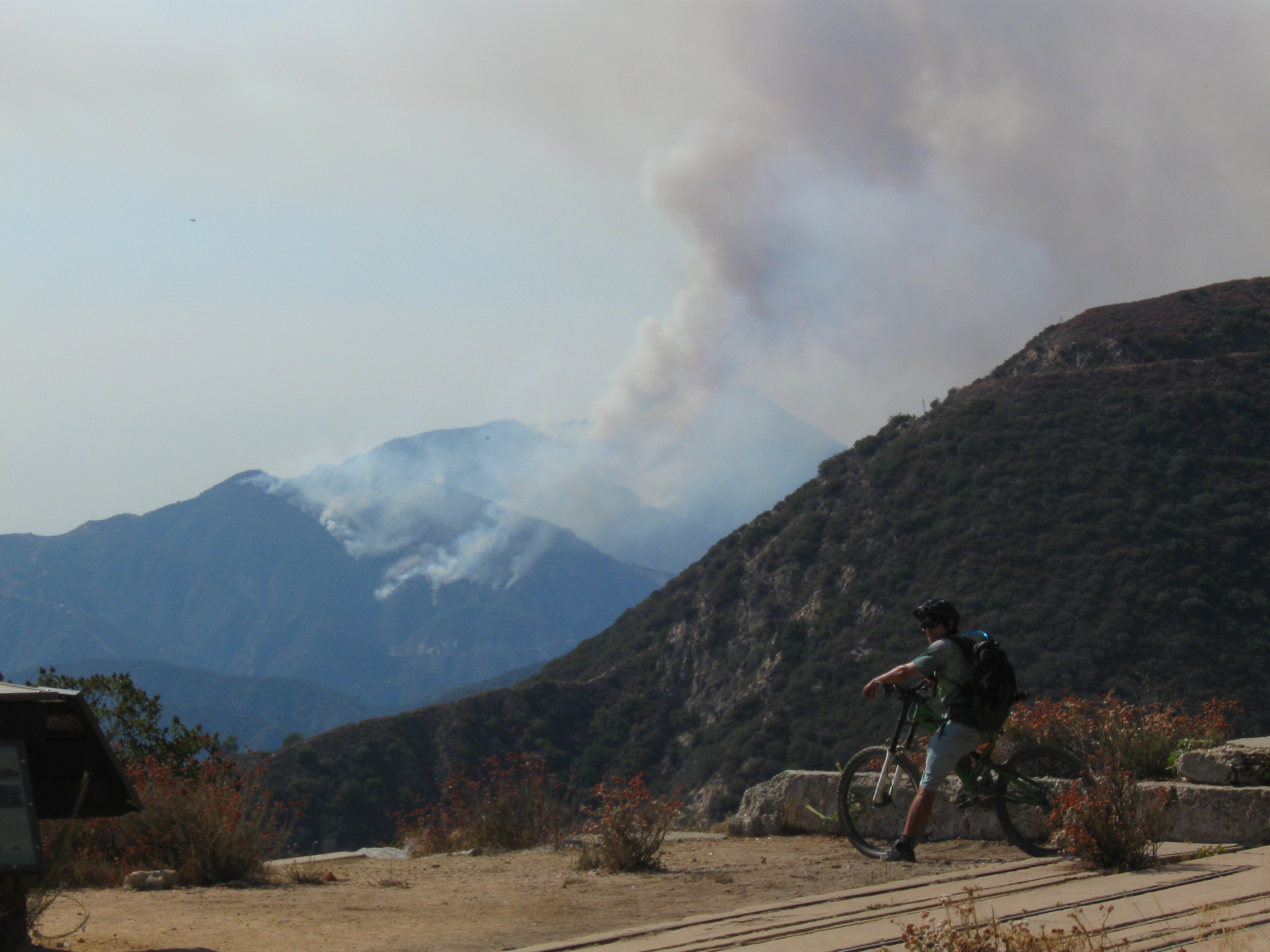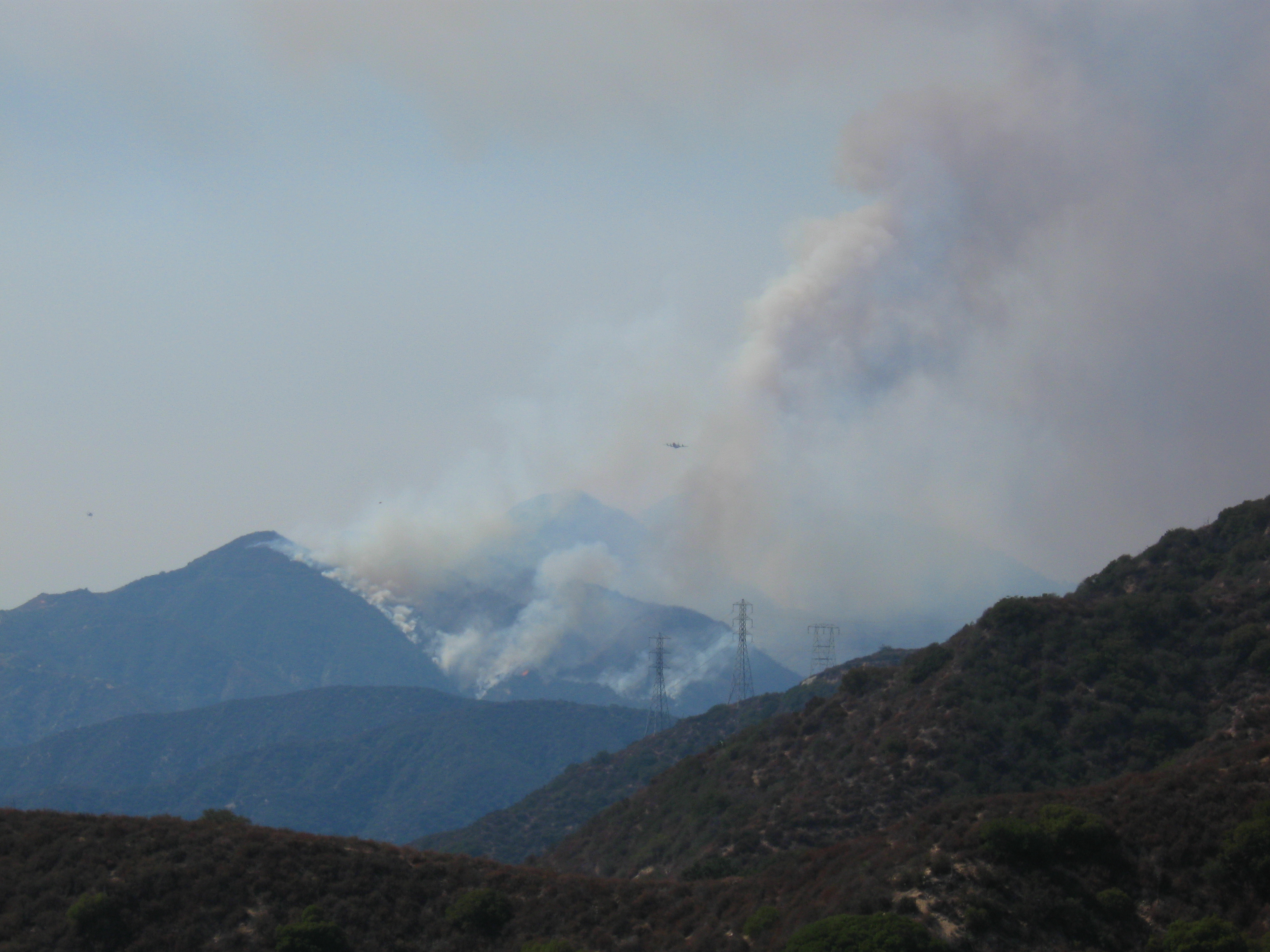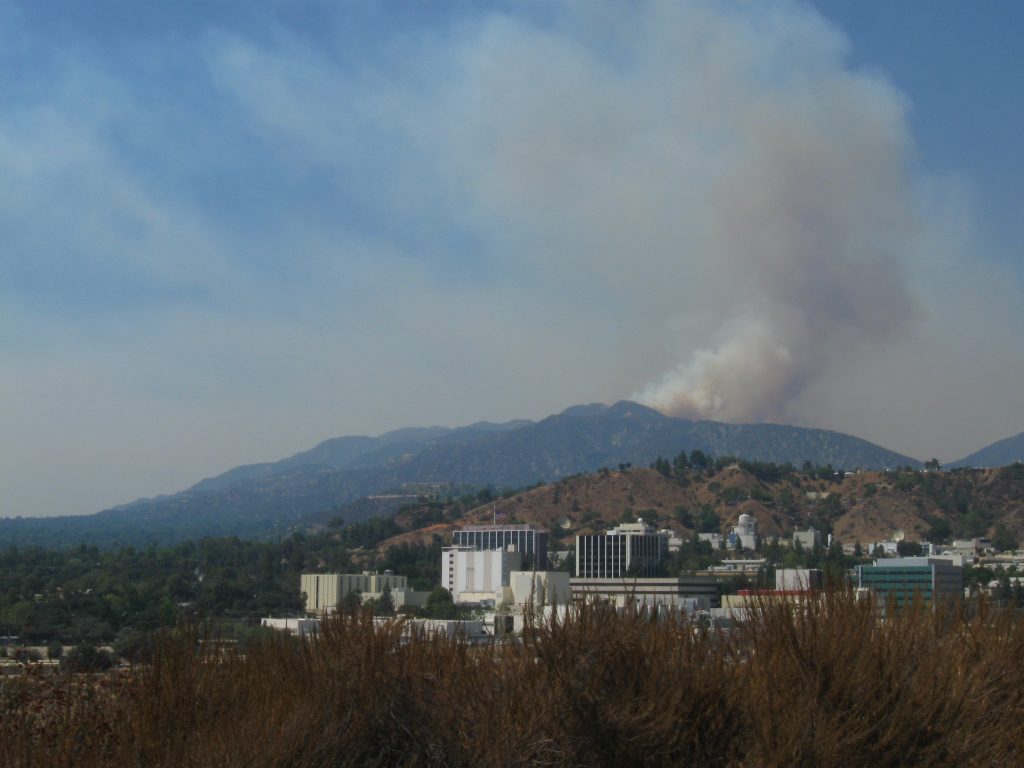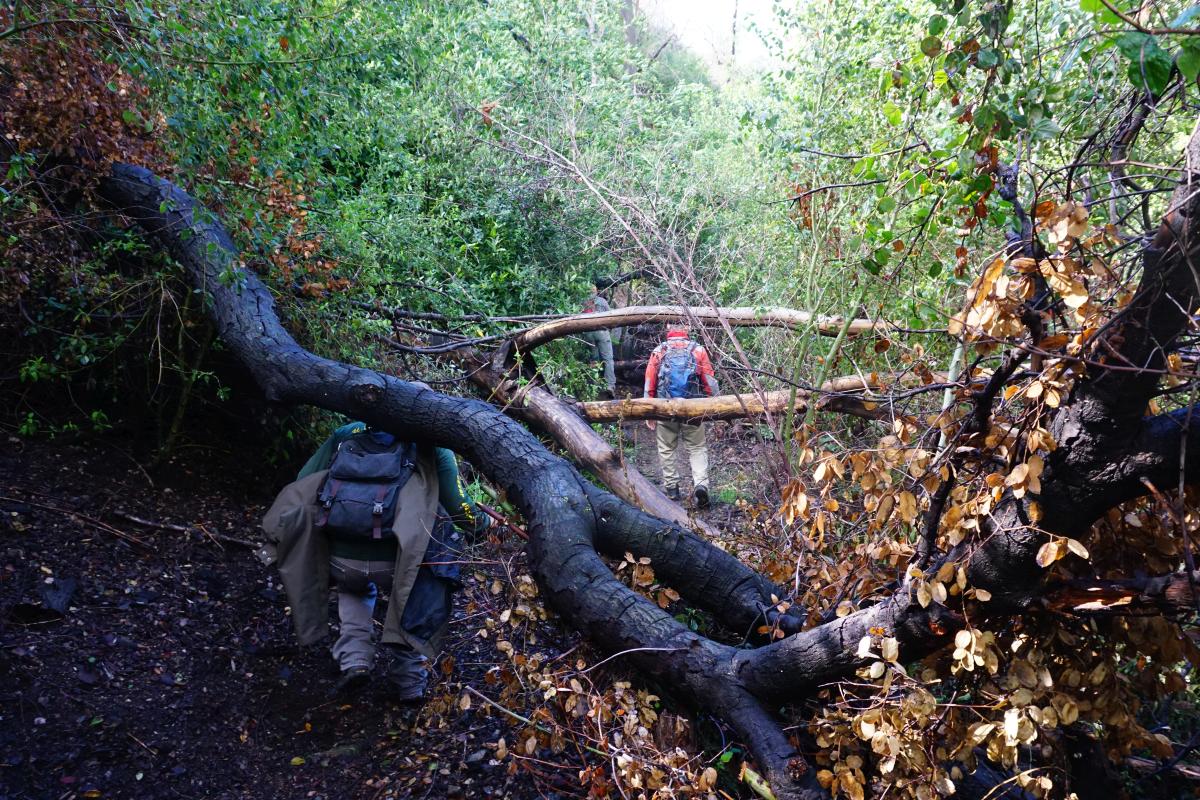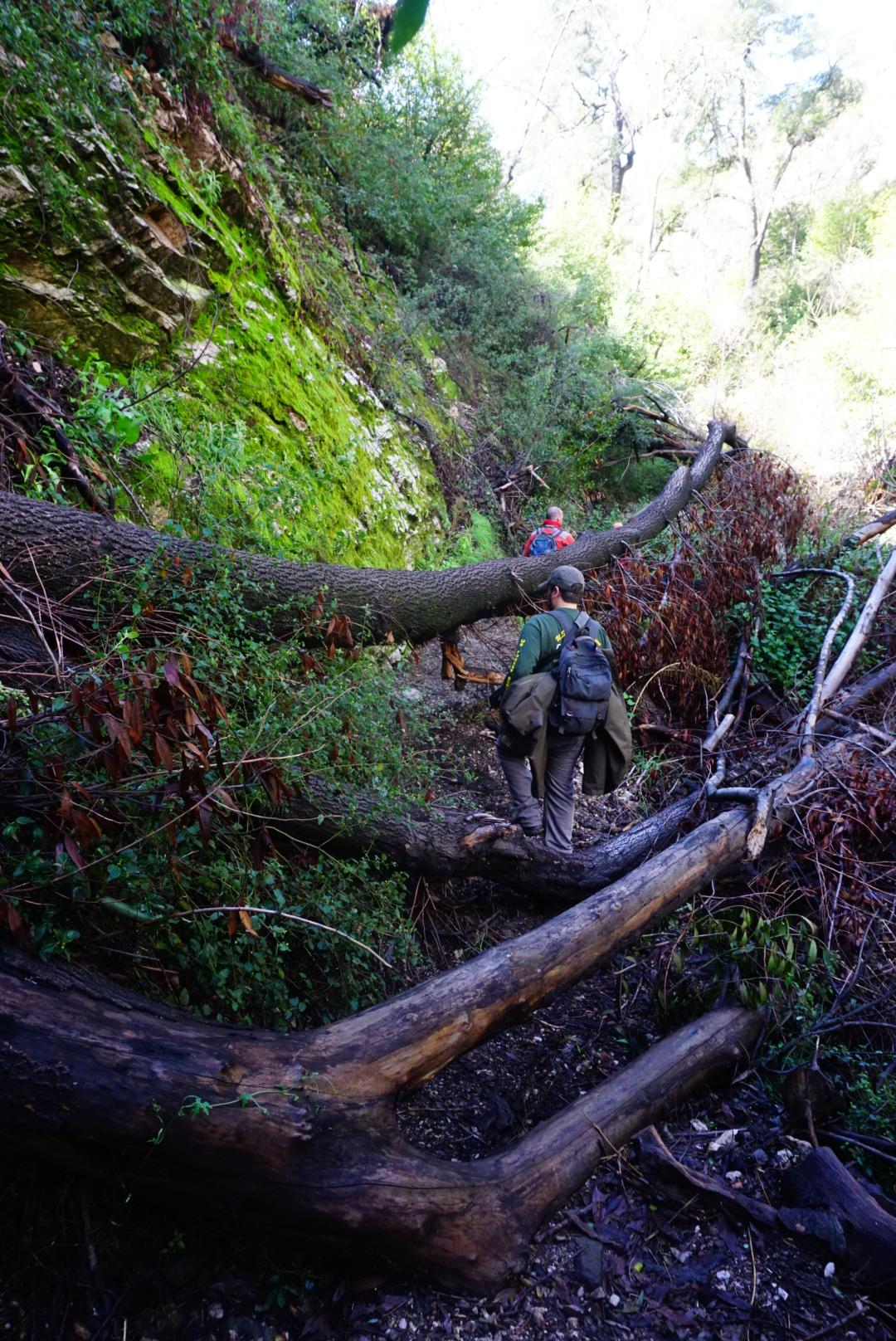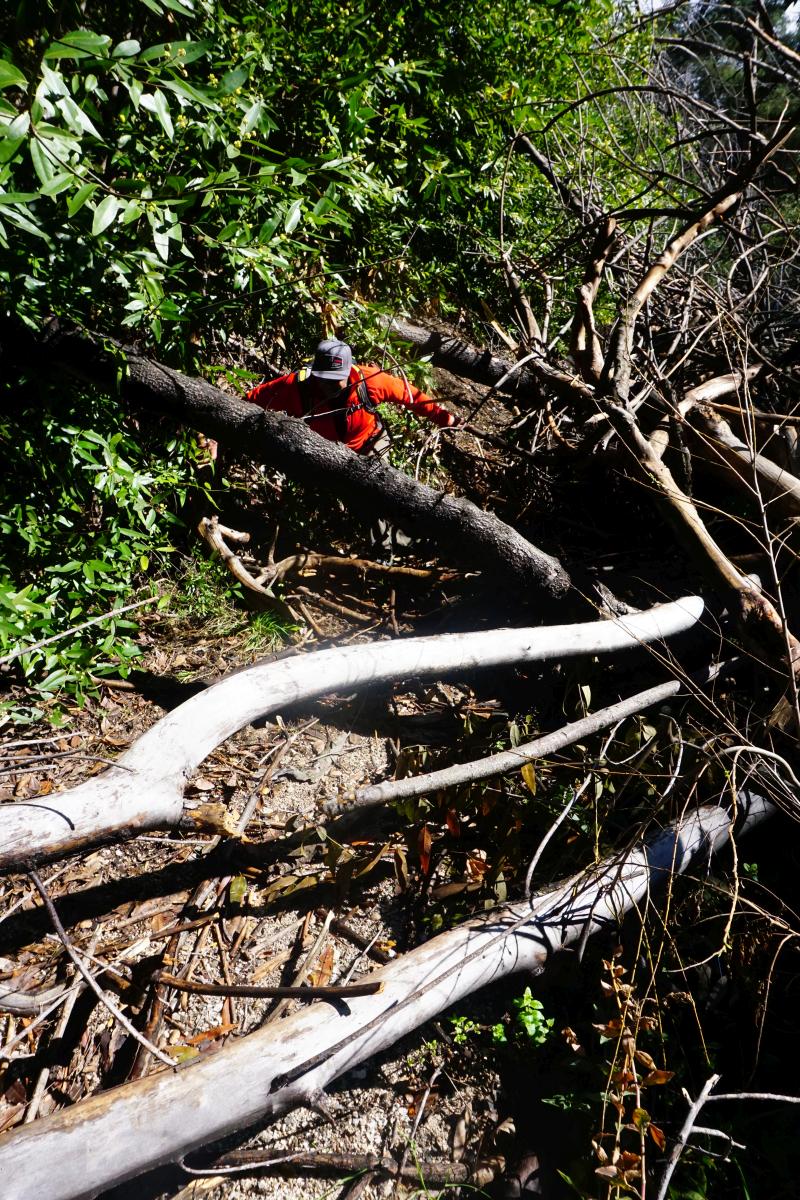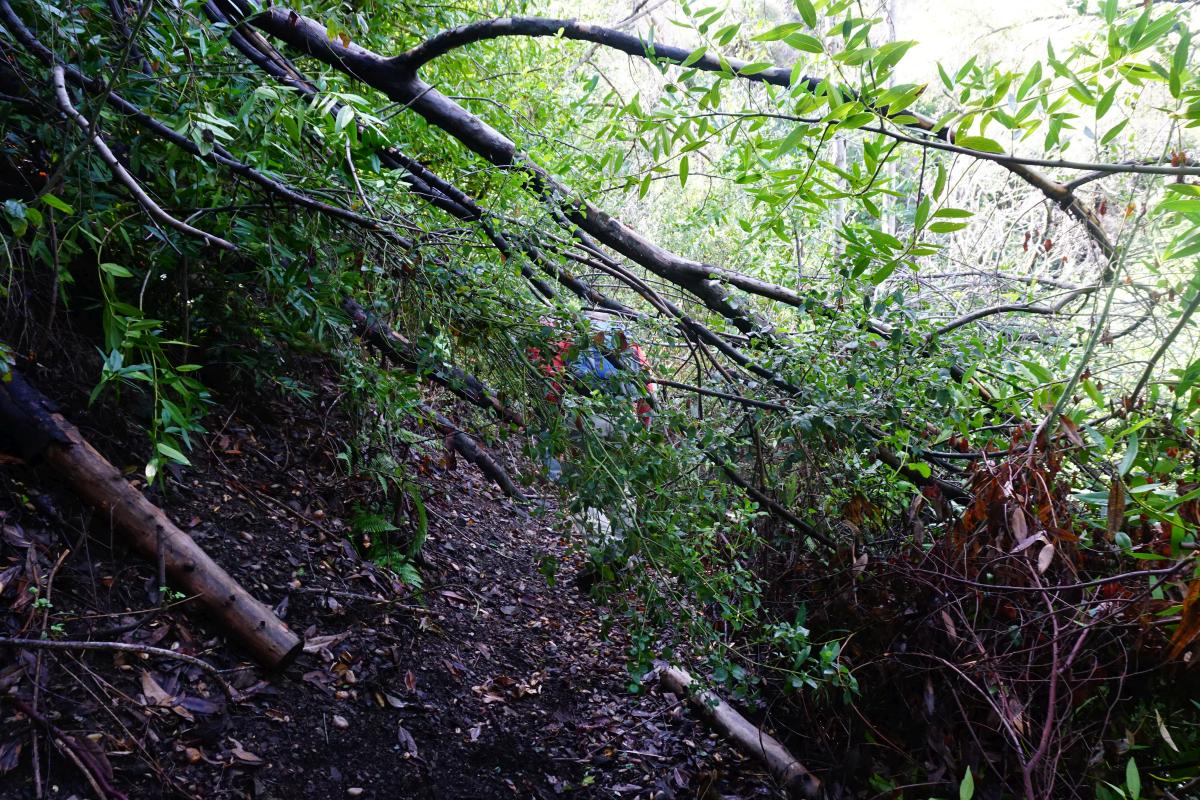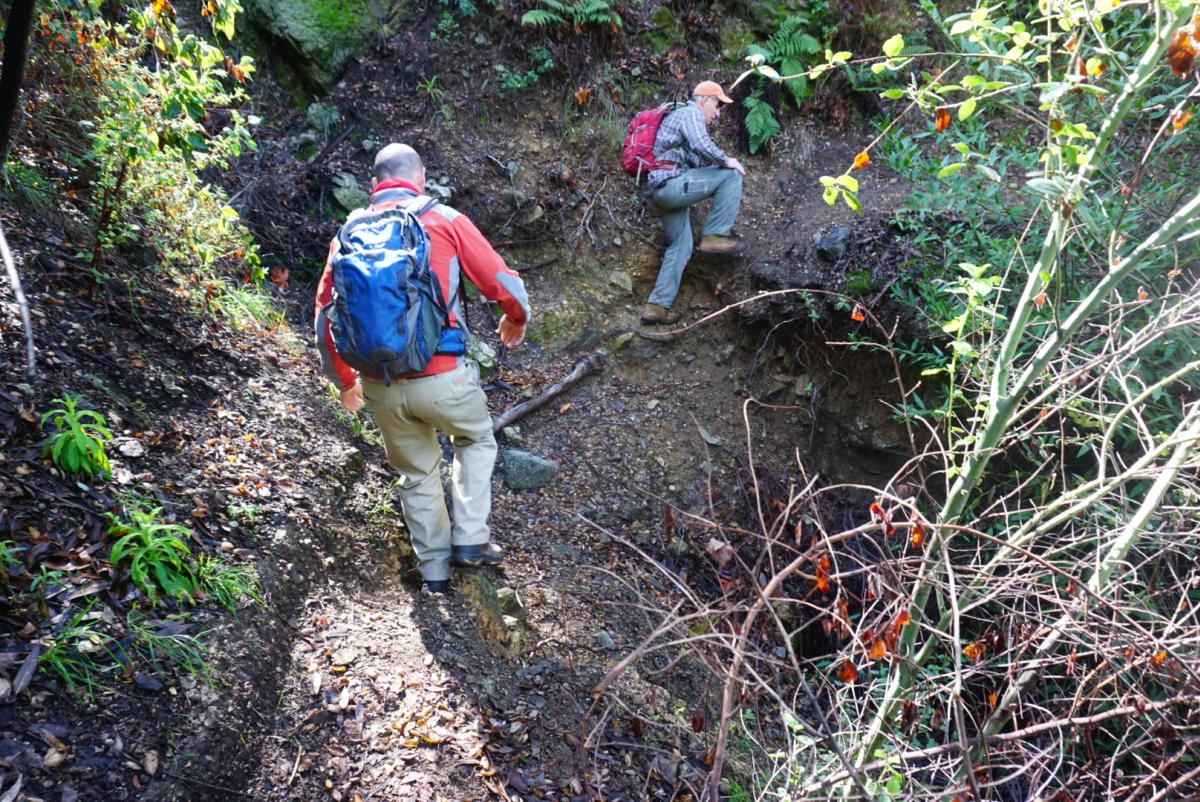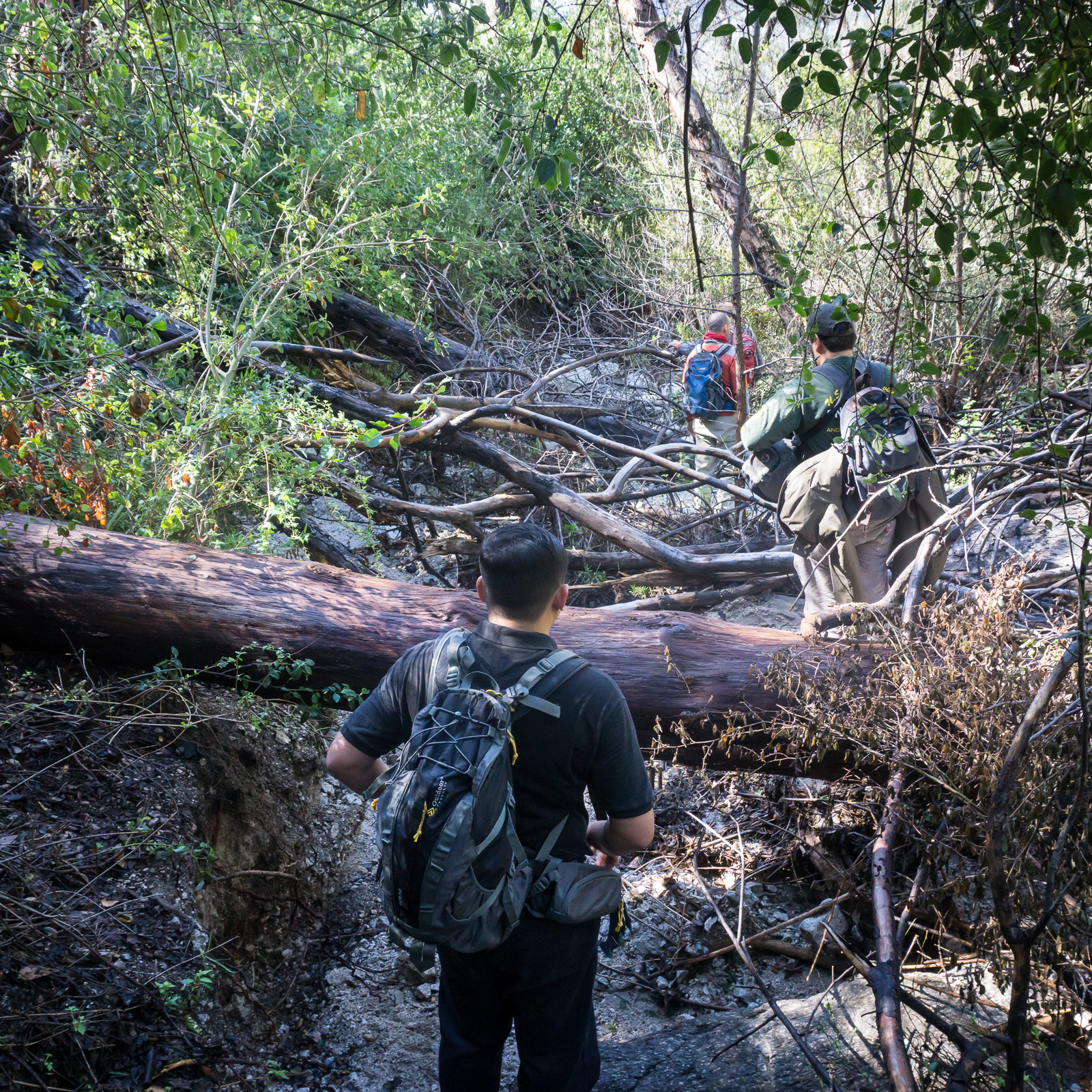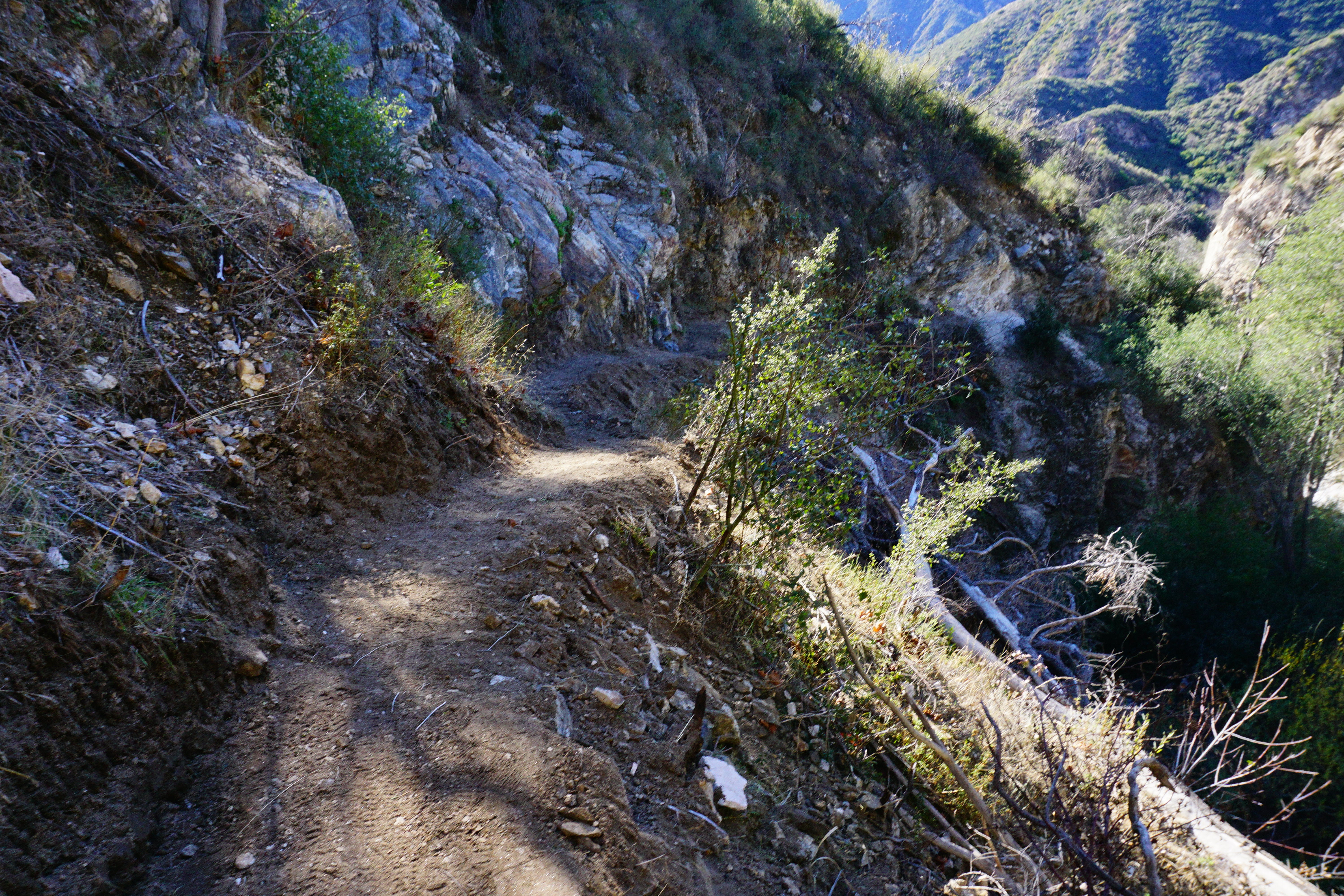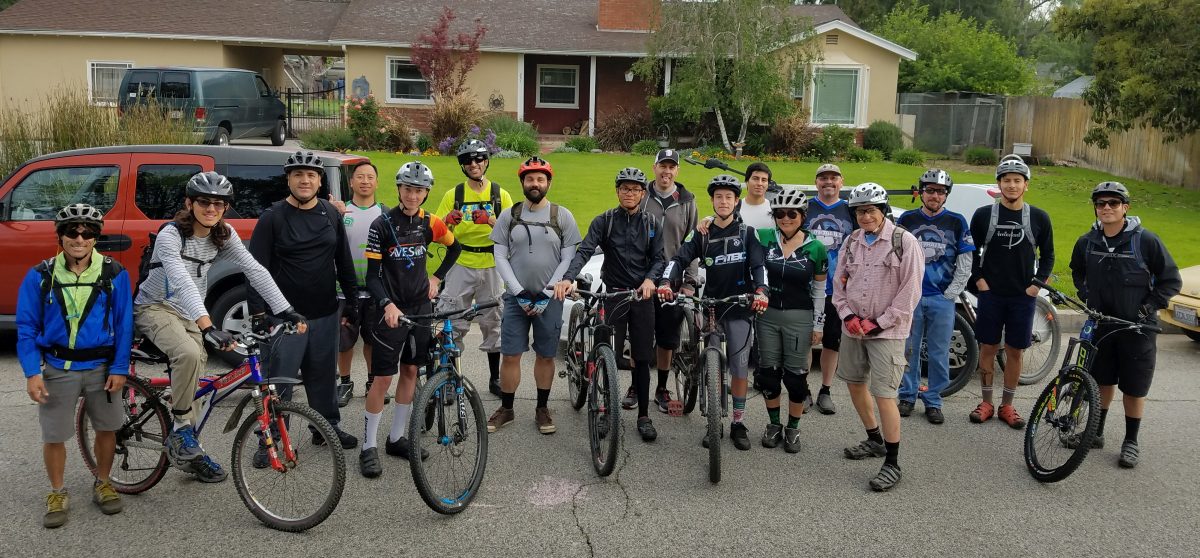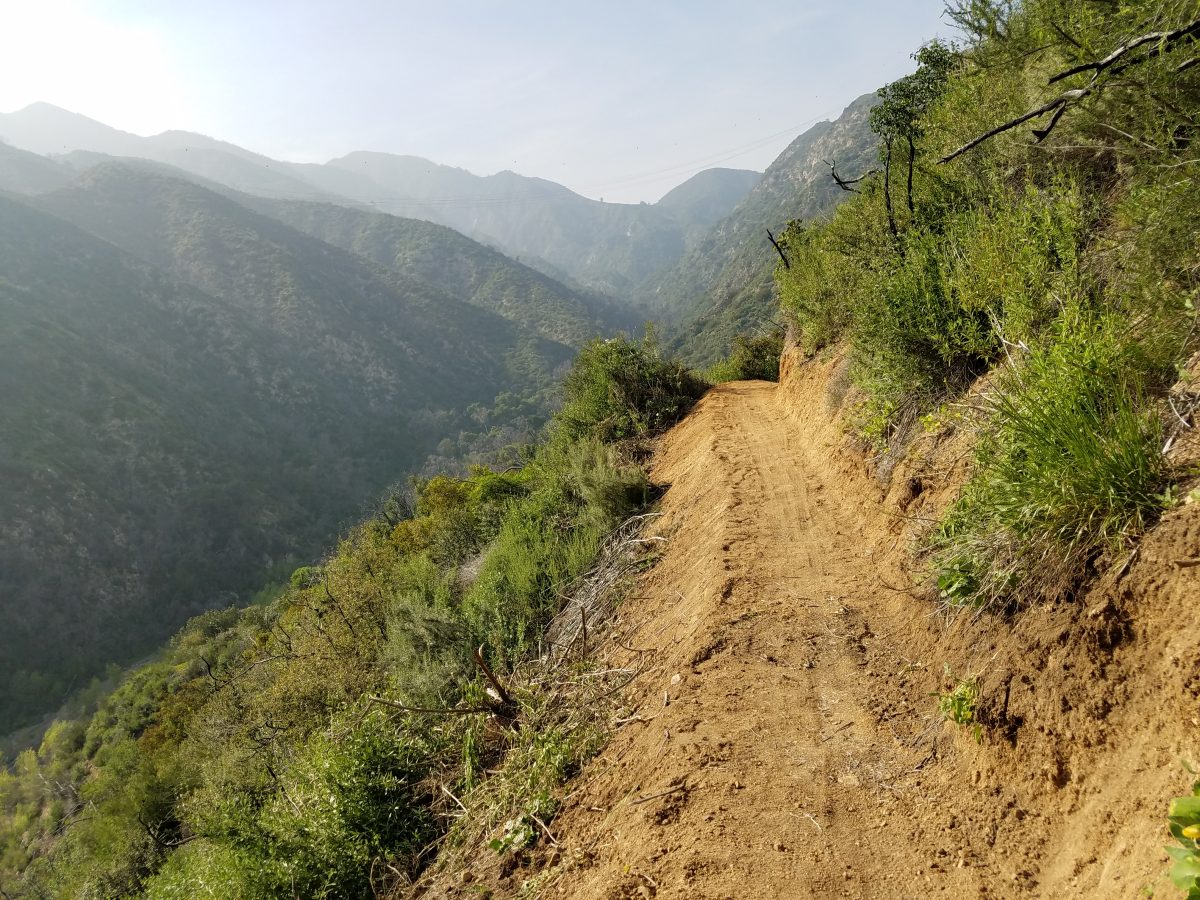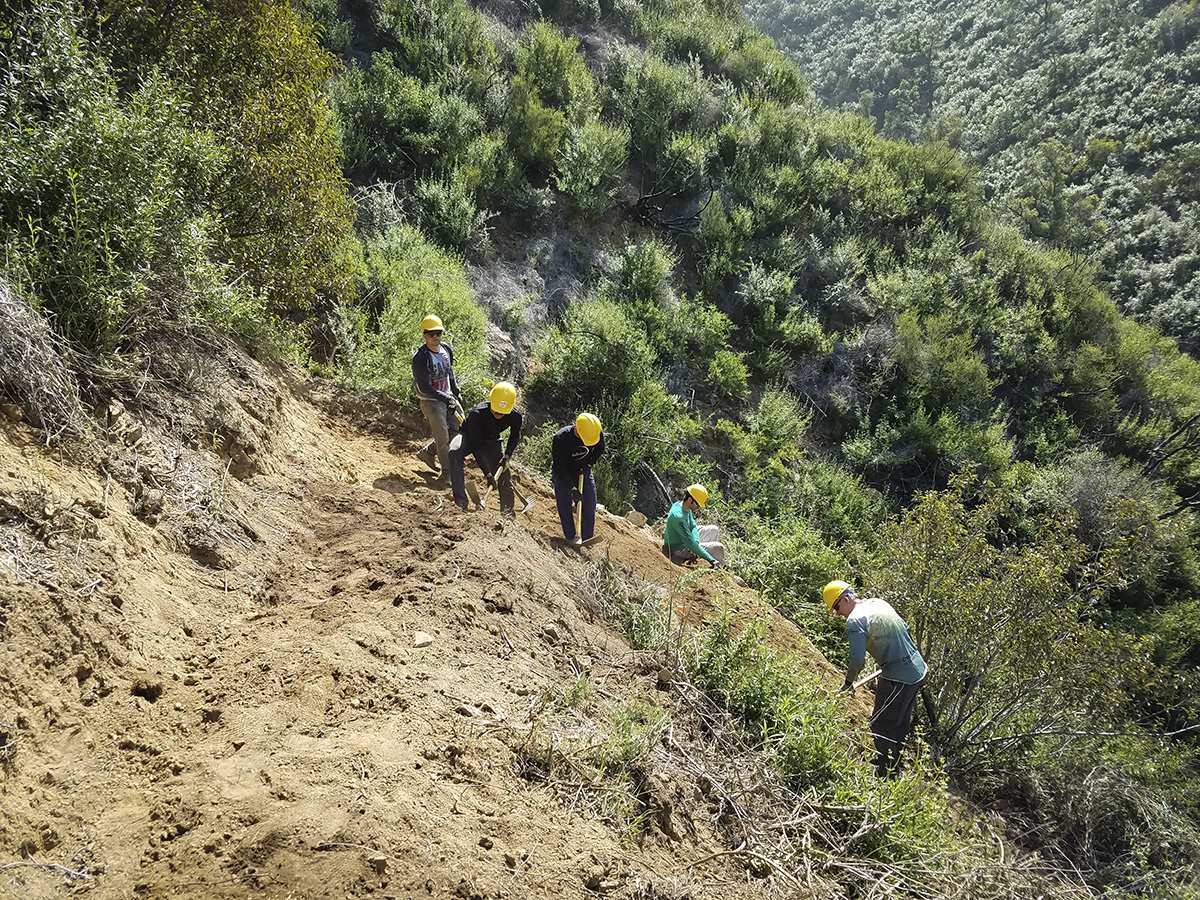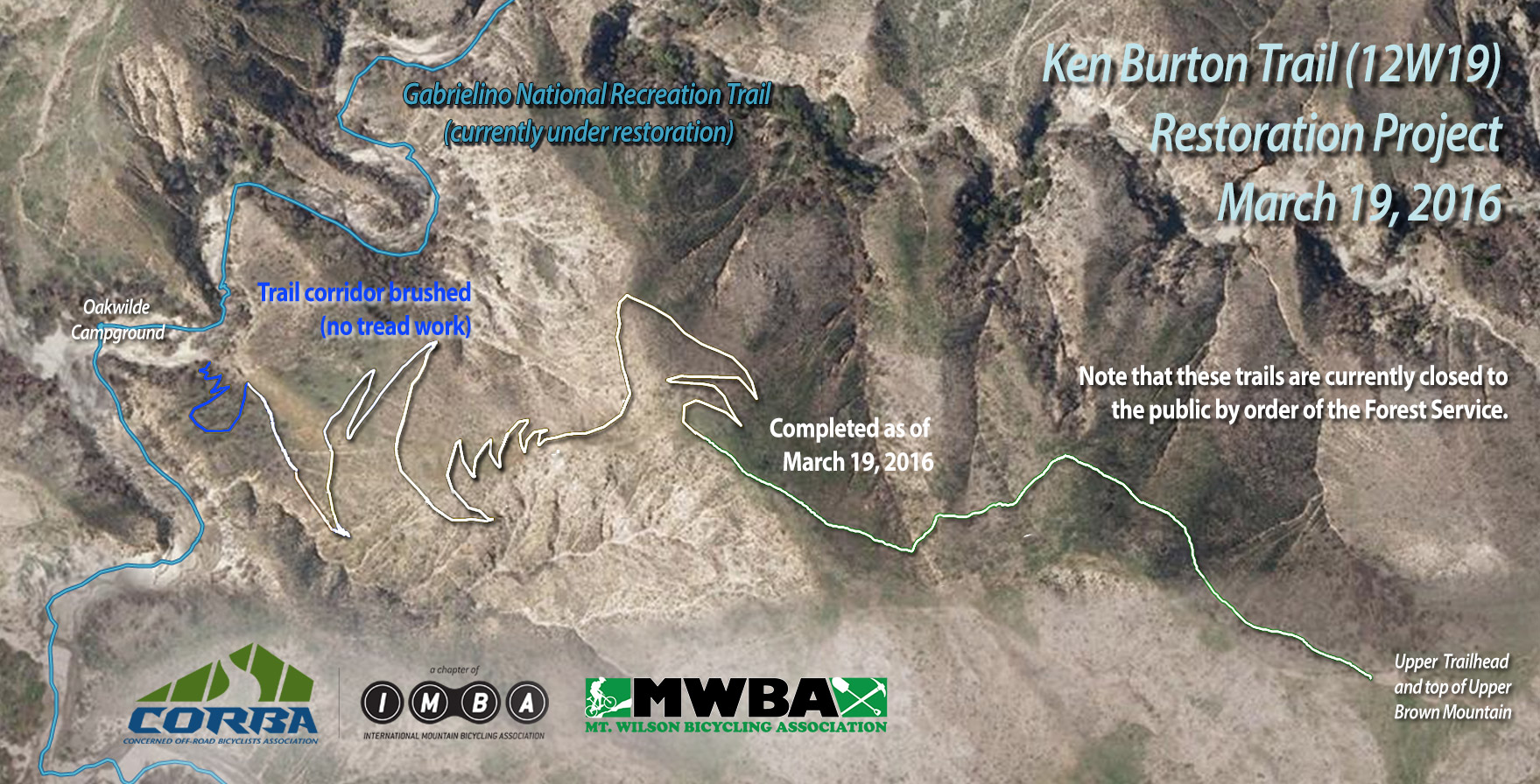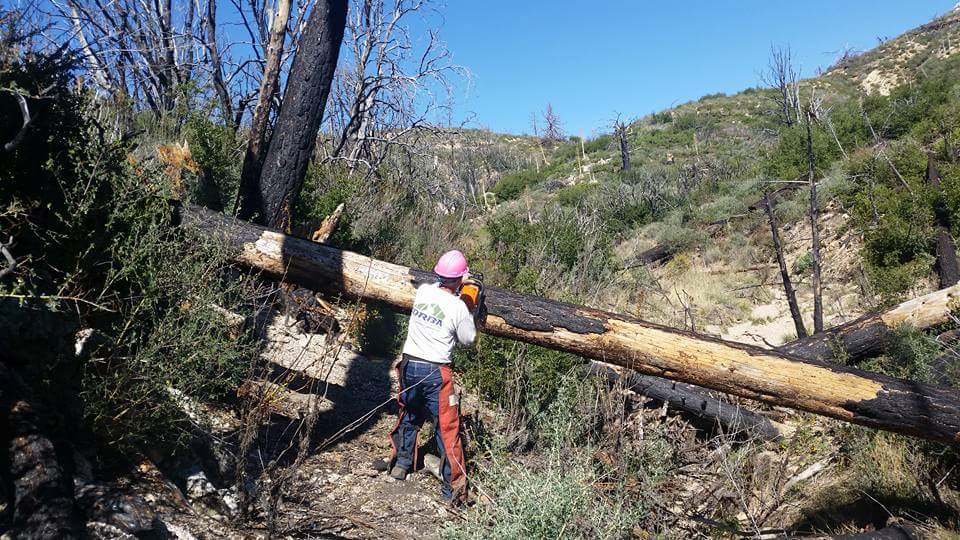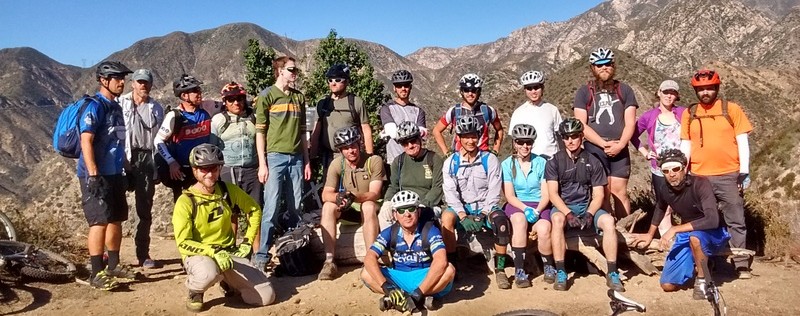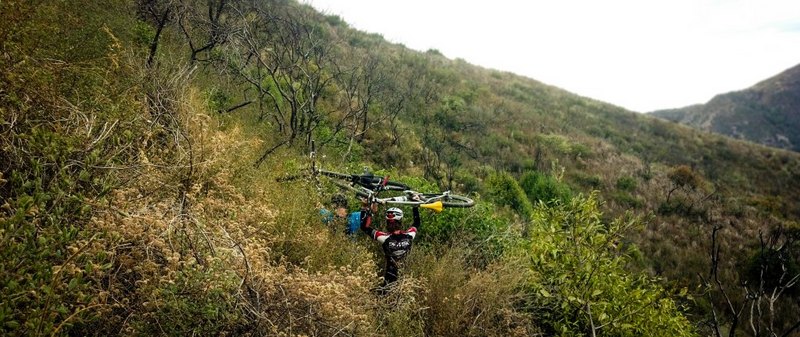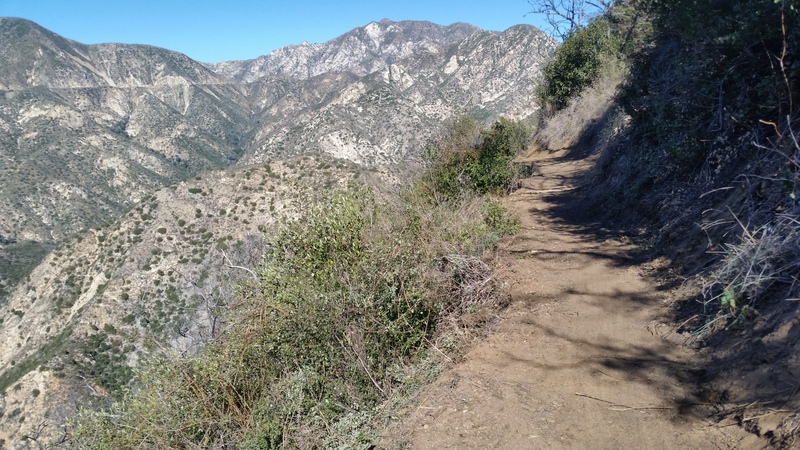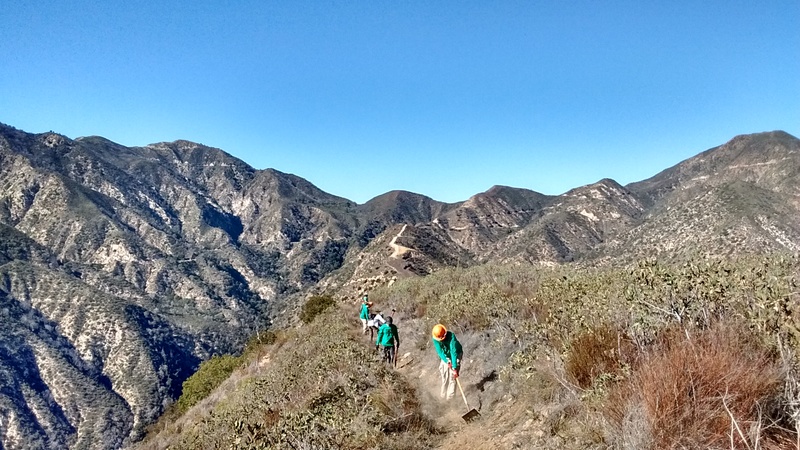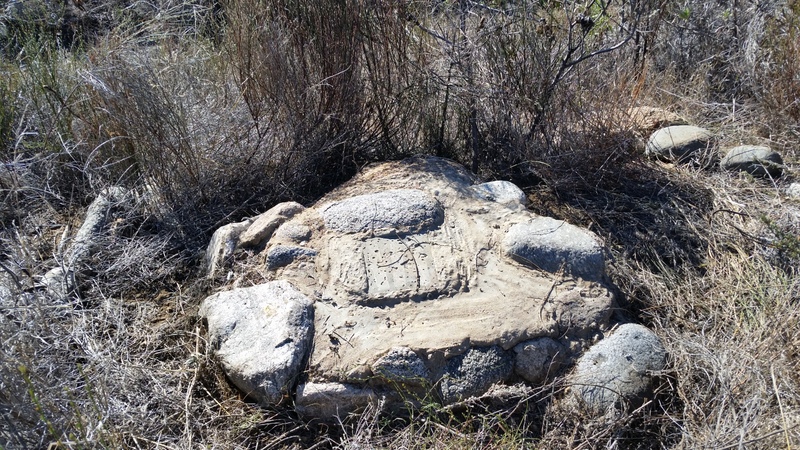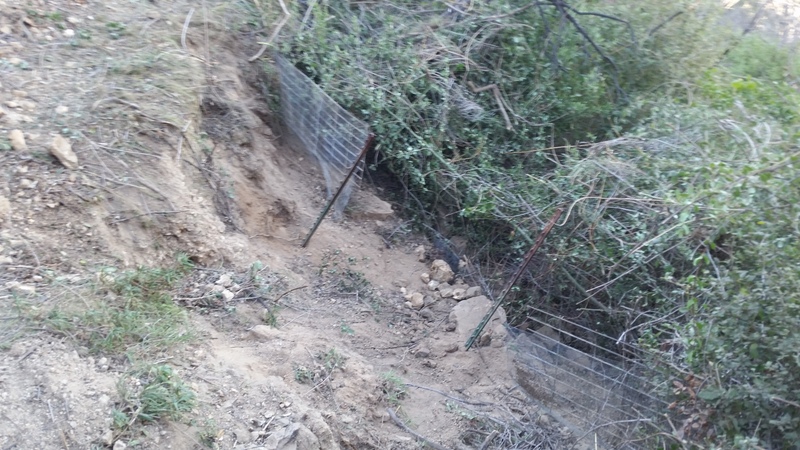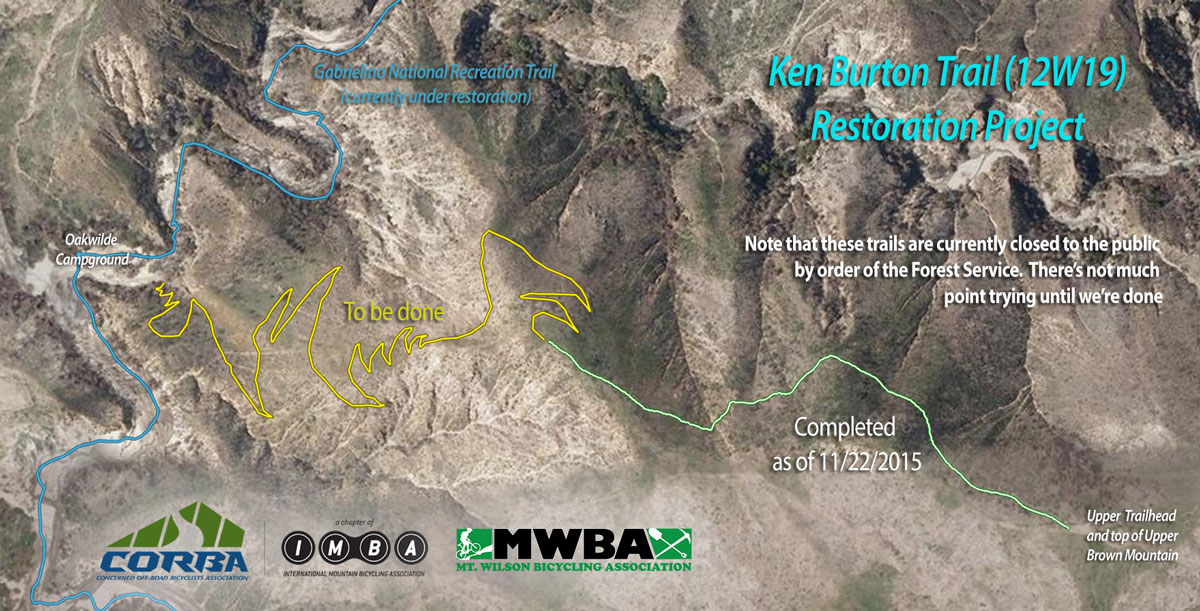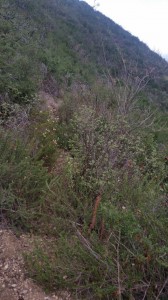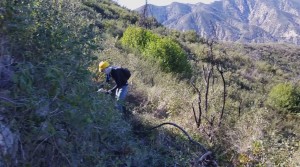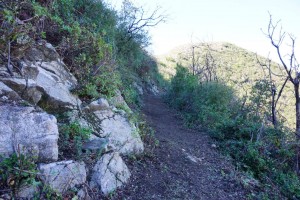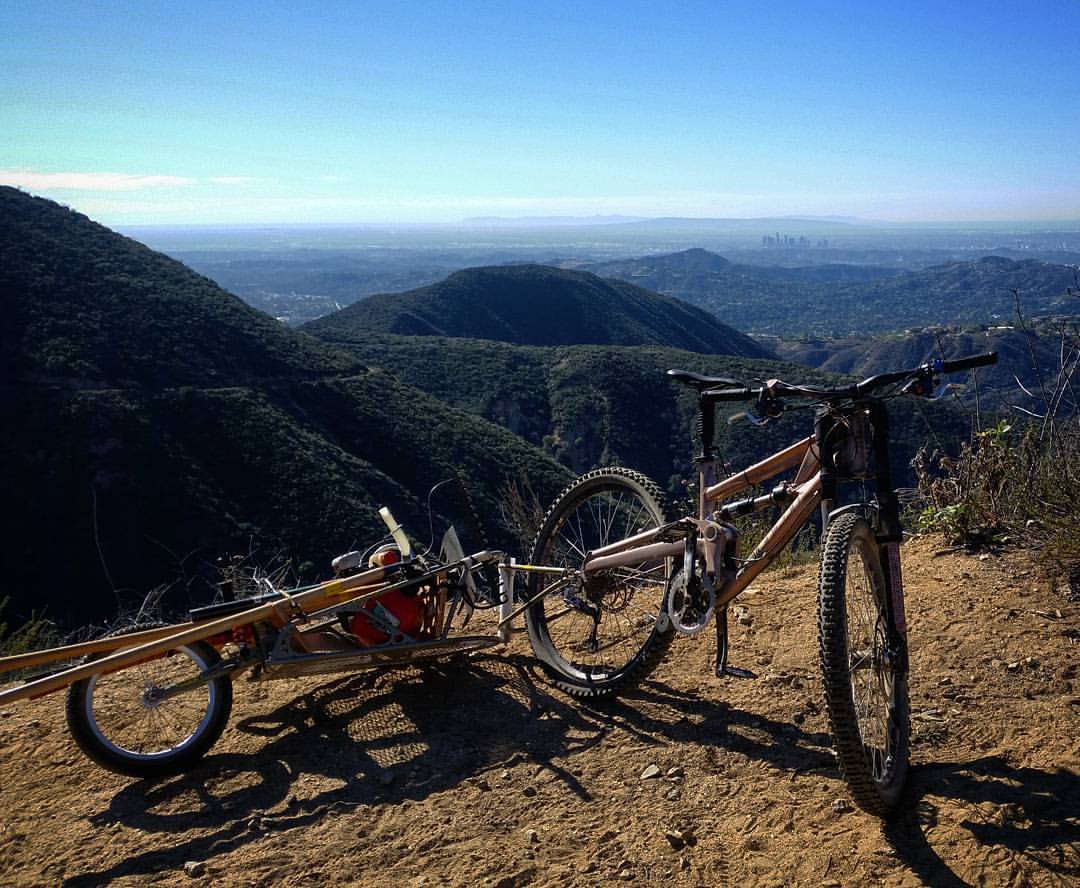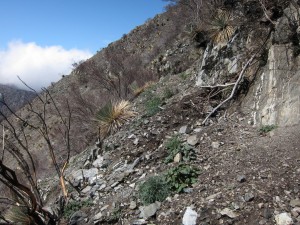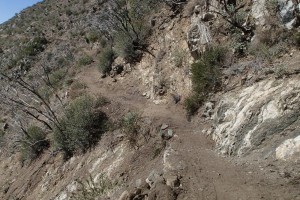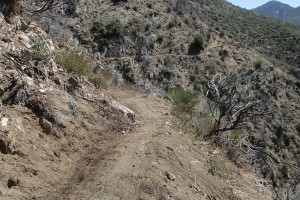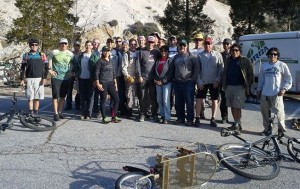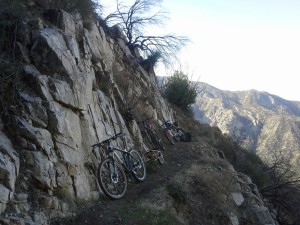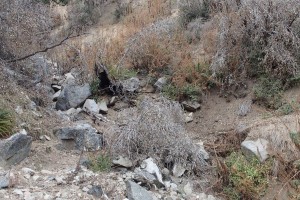Posts Tagged ‘Station Fire’
Station Fire 10 Years Later
Tuesday, August 27th, 2019Trail Users Celebrate: The Gabrielino National Recreation Trail is Back!
Friday, August 24th, 2018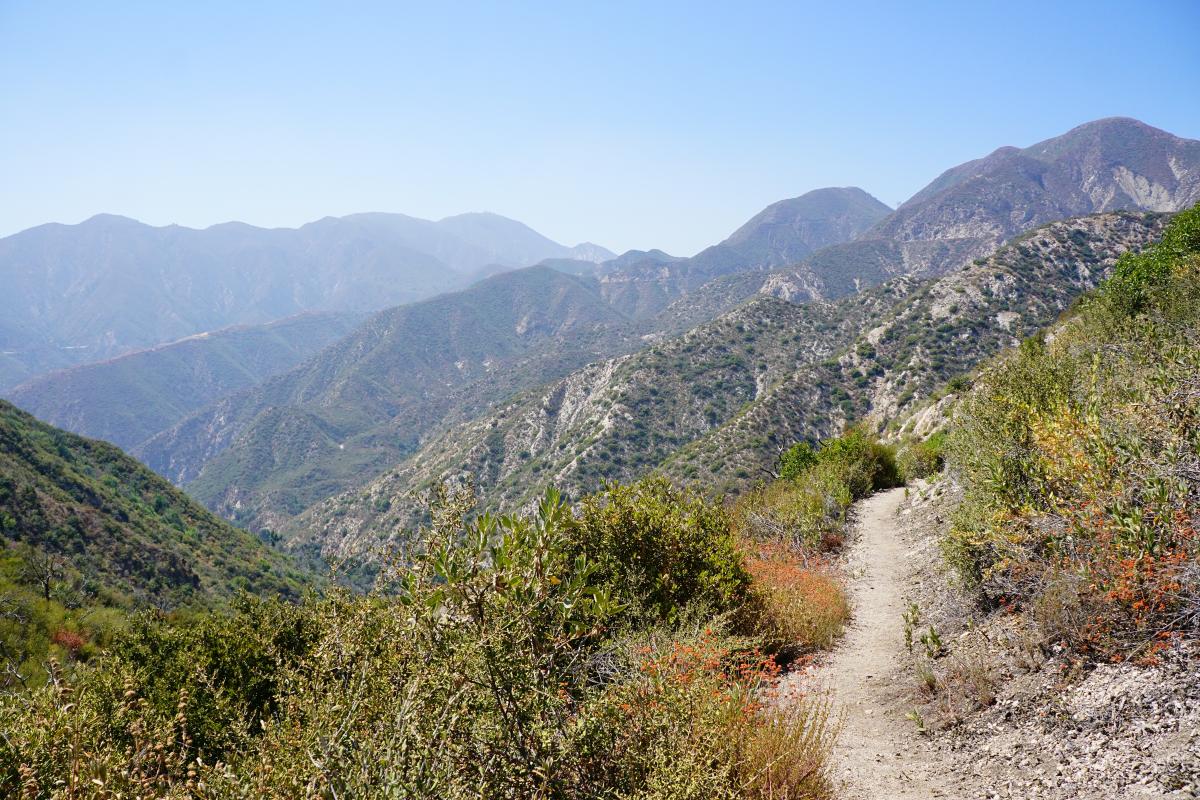
Station Fire trail restoration has been a major focus of CORBA’s for the past nine years. On August 26, 2009, CORBA volunteers were headed out for routine volunteer trail maintenance in the Angeles National Forest. “As I approached our trail work site, I could see a plume of smoke coming from the Arroyo Seco canyon,” said Steve Messer, then a trail work volunteer and now President of CORBA. “We canceled the trail work and watched helplessly as the forest burned for six more weeks.”
Nine years later, almost to the day, mountain biking volunteers have completed restoration of the Gabrielino National Recreation Trail through the Arroyo Seco canyon. This popular section was one of the most heavily damaged by the El Niño rains that flash-flooded the ashen canyon after the Station Fire, taking with it huge sections of the trail and forest. With the extreme damage, this was to be our most ambitious project
With the area completely closed to the public for more than seven years following the fire, the trail was choked off. Hundreds of burned trees had fallen across the trail and several retaining walls had failed. When people began venturing into the area, in many places there was no trail, so people began using the stream bed.
February 2016 hike-through and assessment
In February 2016, Messer hiked the Arroyo Seco section of the Gabrielino Trail with Forest Service officials and others to do an assessment and begin plans to restore the trail. It was an arduous journey, climbing over and under downed trees and thick brush, scrambling across debris fields where there was once a trail, and precariously shimmying along what used to be the trail tread.
After lengthy environmental reviews, the restoration project began in earnest in late 2017. Six volunteer chainsaw operators worked for two days to get the trail corridor opened enough to begin tread work. Downed trees were a constant challenge, and several sections required extensive additional chainsawing through log-jams. It took dozens of bob trailer-runs to get tools in place. Volunteers faced round-trip rides or hikes of ten to twelve miles to get to and from the work site. Some sections of the trail were restored that had failed long before the Station Fire.
The Mount Wilson Bicycling Association (MWBA) led monthly volunteer work days on the trail from November to July. Several volunteer work days were sponsored by local bike shops including Incycle, Pasadena Cyclery, Golden Saddle Cyclery and Montrose Cyclery. There was so much enthusiasm for the project that a few days there were more volunteers than tools.
Generous grants from REI and Southern California Edison enabled CORBA to hire professional trail builders, Bellfree Contractors, to complete some of the more technical work. By far, the majority of the work was done by 102 dedicated volunteers on 283 volunteer days. The 1,900 volunteer hours equates to over $60,000 in value to the Forest Service.
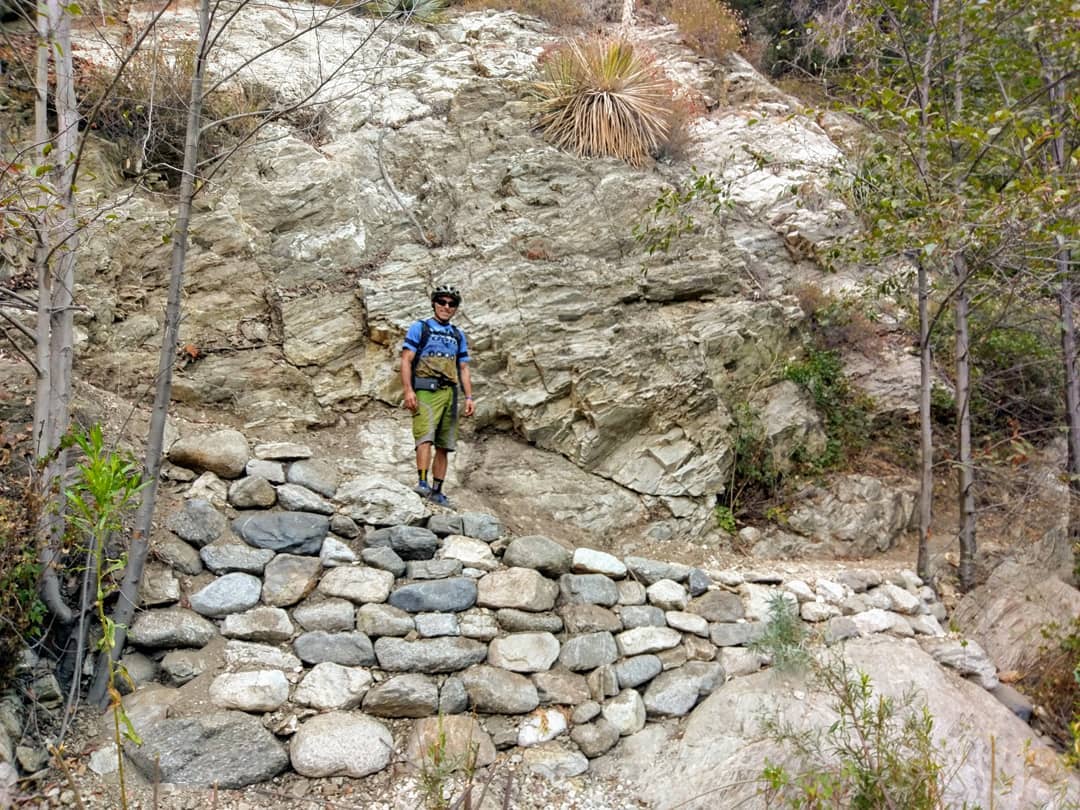
The final work was completed this week with the trail restored to its original alignment. Trail Closed signs had been in place at either end of the canyon since 2009. The signs were taken down this week.
Gabrielino Trail Restoration Update
Thursday, March 1st, 2018CORBA has been working behind the scenes on restoring the Gabrielino National Recreation Trail. The Gabrielino is the last trail still closed because of damage due to the Station Fire. It’s been an ongoing effort since 2011 to open up sections of the trail and then keep them clear of downed trees.
In early 2015 the Los Angeles Conservation Corps worked with Bellfree Contractors to rebuild the Gabrielino from Paul Little to Oakwilde Campground. CORBA helped fund that effort with a generous grant from REI. We subsequently concentrated on the Ken Burton trail, a project that rallied volunteers in an intensive 8-months of bi-monthly work days.
Only the section from Oakwilde to the junction with Bear Canyon trail remains closed to public use. CORBA has been awarded grants from both REI and Edison International to help fund the restoration of this section. Those funds support volunteers, buy tools and materials and will pay for professional services to improve the sustainability of the trail and reduce future maintenance needs. We are grateful for their support.
In early 2016 we did a hike-through inspection of the trail with Forest Service staff, Bellfree Contractors, Los Angeles Conservation Corps and Boy Scout volunteers. The arduous journey involved climbing over and under dozens and dozens of downed trees, searching for remnants of trail where it had been washed away, and dodging and ducking heavy brush. Sections of the trail were completely gone, the only route was to hike along the streambed, which was also covered in downed trees.
After more than a year of internal Forest Service review, the go-ahead was given to us by District Ranger Bob Blount last summer. Sadly, Ranger Bob passed away last week and won’t see this trail completed. He was especially excited for us to be working on this trail and bringing it back to its earlier glory. We hope to finish the project by summer in his honor.
After months of extreme fire danger (meaning no chainsaw use), last fall CORBA and MWBA volunteer sawyers spent six solid days wielding chainsaws to cut through the deadfall along the trail.
With the corridor opened up, MWBA have devoted their monthly trailwork day to the project since December. In three work days the volunteer crews have worked on just over two miles of the trail.
There is so much enthusiasm for getting this trail restored and opened that there have been more volunteers that tools for the last two days. The volunteer effort has been astounding, with more than 40 volunteers signed up each day. Some sections that have been worked on are now in better shape than before the Station Fire. But there is still much to do.
So far, over 50 individual volunteers have devoted more than 1000 hours to the restoration effort.
This is truly a team effort, with the Angeles Forest 50k Run trail crew having worked on another section of the Gabrielino near Switzers; the Sierra Club have been working on the section around Devore camp; and previous work was done by the Los Angeles Conservation Corps and the Boy Scouts on other sections.
Thanks to all the volunteers who have contributed to this restoration effort. Special thanks to our partners at the Mount Wilson Bicycling Association for organizing group work days and REI and Edison International for their financial support.
There is still more to do. The trail is not officially open to the public, but we hope to change that soon.. Watch for upcoming announcements for March and April volunteer work days from MWBA, or CORBA’s Meetup group.
Ken Burton Trail Restoration – Day 14
Sunday, March 27th, 2016Saturday, March 19, 2016, was a perfect day to do trailwork. There was moisture in the ground from the week’s rain, temperatures were cool, and the crew were able to ride to and from the work site via the Gabrielino trail. A half-dozen or so volunteers were already on their way to the work site when this group photo was taken.
While several volunteers rode in via the Gabrielino, some opted to ride up to Brown Mountain and enjoy the fruits of their labor on the way down Ken Burton trail to the work site. It was the first time we had been able to ride all the way down to the 16th switchback without interruption. The volunteers who rode down Ken Burton trail were all in agreement that the efforts of the group over the previous five months had been well-worth the experience.
We were fortunate enough to have several SoCal High school league student-athletes and coaches join us for the day, along with members of the IMTBTrails.com mountain bike forum out of Santa Clarita.
With the major brush work completed, the crew split into groups, concentrated on re-cutting the bench along a heavily damaged section of the trail, restoring outslope, and removing remaining roots and stubs from the tread.
Another crew worked diligently to rebuild the 16th switchback, using rock extracted from the tread to build an outside retaining wall on top of the old wire basket retaining structure that had failed. By day’s end, the switchback was completely rebuilt. We were fortunate to have the expert assistance of Hans from Bellfree Contractors on this major effort.
By day’s end the crew had completed tread work almost all the way down to the 17th switchback, restoring one of the more heavily damaged sections of the trail so far.
So far, 81 individual volunteers have put in 1,408 total person-hours of work on this project in 14 scheduled work days, plus another 12 prep days. This is an impressive effort to restore this much-loved trail that was built by mountain bikers from the Mount Wilson Bicycling Association in the early 90s.
The next scheduled group work day on Ken Burton will be with Mount Wilson Bicycling Association on April 17, though there will be additional prep days before then. Contact Steve@corbamtb.com if you’re interested in helping prep before then (likely April 10).
Vetter Mountain Trail Restoration Progress
Wednesday, December 30th, 2015Last January the Forest Service allowed some experienced trail maintenance volunteers, who had been previously certified to use chainsaws at the “A” level, to step up their training to a “B” level. Under current regulations, A level sawyers are restricted to 8 inch trees or smaller, and must be supervised. B-level Sawyers are allowed to work unsupervised, on trees up to 24″ in diameter, and can supervise and work with A-level sawyers.
CORBA President Steve Messer, and volunteer Mike McGuire both received their B level certification, and have been putting them to use all year. MWBA volunteers Mitch Marich, Brad Benam and Erik Hillard also received their A level certification, along with several other individuals and volunteers from other organizations and areas outside Los Angeles.
Together the CORBA and MWBA sawyer team has been cutting trees from trails all year. We’ve cut trees from Brown Mountain, El Prieto, Sunset Ridge, Gabrielino, Strawberry Peak, Colby Canyon, Mount Lowe East, Sam Merrill and Silver Moccasin trails. Six years after the Station Fire, downed trees are becoming a major and constant problem.
Our biggest project has been Vetter Mountain trail. This was a favorite of local mountain bikers, as the first descent of the classic Chilao Loop (or, more accurately, the Chilao Figure-8). The area was one of the most heavily impacted areas of the forest by the Station Fire. Drought has slowed the area’s recovery, and there are still thousands of dead trees waiting to fall.
We began in early spring 2015, first clearing the Charlton Flats loop road of more than two dozen downed trees just to get to the bottom of the Vetter Mountain Trail and Silver Moccasin trail. We cleared all the deadfall from the lower section of Vetter through to the first road crossing. There were many trees beyond our chainsaw certification level, the largest being just over 50 inches in diameter. These were taken care of by Little Tujunga Hot Shots Captain Greg Stenmo, whose support we were grateful to have.
After the summer heat and when fire danger levels and wind conditions allowed, on October 3rd CORBA and USFS volunteers Mike and Robin McGuire returned to begin work on the next section of the trail. In a day’s work, they were only able to clear the first hundred feet of the trail, with the sheer number of trees stacked like Chinese pickup sticks.
We returned on October 8th. In the five days since Mike and Robin were up there, another four trees had fallen across the road. Finally getting to the trail, we began cutting downed trees, poodle dog bush and buckthorn from the overgrown tread. In places it was impossible to see any remnant of trail through the brush and deadfall, so having been familiar with the trail in its pre-fire glory was a must. The time lapse below gives a pretty good indication of what’s been involved in clearing the trail. This is six hours of work compressed to nine minutes.
We returned on October 23, and November 5. On November 5 we started from the top of the trail, near the site of the old lookout and worked our way down. It was a glorious moment for us to finally have cut and cleared over 150 trees from Vetter Mountain trail, Charlton trail, and the Charlton Loop road. After finishing, we went back and inspected the trail from top to bottom, and found a dozen more trees fallen in areas we’d previously cleared.
Once again we returned on December 17, first clearing downed trees off the road, then several new trees that had fallen across Vetter and Charlton trails. Afterwards we joined the Chilao hotshots crew, who were clearing downed trees from Silver Moccasin trail after the particularly strong windstorms of December. With our help, they were able to get the job finished in one day.
The trail remains closed to the public. There are still too many dead trees that have been rotting away for six years, waiting to fall every time the wind blows. More than once, when we finished our day’s chainsaw work as the afternoon winds started blowing, we heard more trees falling. Because of these dangers, we are not willing to take in volunteer crews to begin restoring the trail. Since winds have been blowing steadily this past month (over 70mph the week before Christmas), there are probably many more trees down again.
Currently the Forest Service, along with Fire Crews and us as Volunteer Sawyers, are developing a plan to clear remaining standing trees in the trail and road corridors, so that they don’t continue to fall across the trail every time the wind blows. Currently crews are doing that along the Santa Clara Divide Road so that it can be reopened to vehicles next year.
We hope to begin restoration work on the Vetter Mountain trail next year, after we finish the Ken Burton trail. Stay tuned for details.
Ken Burton Trail Restoration Continues December 13
Wednesday, November 25th, 2015On Sunday, November 22nd, 2015, we had our third full trail restoration work day on Ken Burton trail with the Mount Wilson Bicycling Association. 23 volunteers made the 7 mile, 2000′ climb to pitch in. Bob trailers were used once again to get needed tools and supplies to the work site.
We continued on from where we finished last time. The crews worked feverishly for a solid four hours, clearing an additional 1600′ of trail. We’re making rapid progress, thanks in part to the excellent original construction by the Mount Wilson Bicycling Association in the 1990’s.
The before and after is quite dramatic. Where the trail was previously completely obscured by brush, it is now in better shape than before the fire. Our crews are getting it down to a fine art. We’re using power hedge trimmers for the initial brush clearance, followed by swampers (who remove and stash the cut brush), then loppers and hand saws to fine tune the brush and stump removal. The lead crew is followed by a tread crew, working to remove stumps and roots from the tread, and pull down slough to restore the original trail tread. We’re cutting the trail to its original 36 – 48″ tread width where possible, knowing that it will narrow down again with time.
Our target for the day was to reach the Ken Burton Memorial, a plaque dedicated to USFS Battalion Chief Ken Burton, who was killed in a car crash in November 1985. For those who remember the trail, the memorial was just before the very first switchback descending into the Arroyo Seco canyon. We made it to the Memorial at about 1 p.m., leaving time for people to gather tools, load up trailers and ride back down for lunch at 2. Pat Phillips, a local Altadena resident and one of the original construction crew in the 1990’s, graciously hosted us for lunch afterwards.
We’ve also reached the first failed retaining wall structure. In my survey of the trail, only two sections of retaining wall structure failed out of the dozens used, a testament to the work of the original MWBA crew. Those dozens of structures have survived three major El Nino winters and one Station Fire.
So far we’ve cleared approximately .7 miles of the trail, about 1/3 of the work. We have a couple more days of very similar work before it will get especially thick and tough near the bottom. At that time we’ll need to coordinate with the Los Angeles Conservation Corps who are working on the Gabrielino trail, near where it meets the bottom of Ken Burton trail.
Thanks again to all the volunteers who came out to help. Our next work day is December 13 (weather permitting). Our tentative dates starting next year are January 10 and January 24, to be confirmed soon. The more people who contribute, the better our chances of riding this trail next summer!
Ken Burton Trail Restoration Has Begun
Tuesday, November 10th, 2015Earlier this year, CORBA used a generous grant from REI to help fund the restoration of the Gabrielino trail to Oakwilde Campground and the Ken Burton trail junction. Pooling resources with the Los Angeles Conservation Corps, CORBA helped fund a private contractor, Bellfree Contractors, to oversee volunteers and Conservation Corps crews, taking the lead on the project. The trailwork needed was so extensive it required the review and approval of Forest Service staff engineers. Much of the trail was completely gone, having been swept away in a massive landslide, or gouged into a ten-foot-deep, twelve-foot wide gully where once you could step over a trickle of water as it crossed the trail. That work was begun last spring, and Los Angeles Conservation Corps continue to work on the Gabrielino in the area. The Trail remains closed to the public beyond Paul Little campground/Brown Mountain Dam while restoration efforts continue.
Meanwhile, we were given permission to begin work on the Ken Burton trail earlier in summer. Work began in October with the trail being inspected, and in many cases searched for using older GPS tracks, by CORBA volunteers. On Saturday, November 7th six volunteers came out to begin work on the trail. Just getting to the work site requires a 2000′ climb over 7 miles, with several steep, loose sections that are difficult without carrying tools. In one day’s work, we were able to clear brush from about a quarter mile of trail, and restore tread on just over half of that. The tread, once cleared of brush, is generally filled with loose slough that’s easy to clear, but is otherwise intact. A few retaining wall structures near the top have failed and will require digging out the old materials–iron posts, steel mesh, wire and screen–and replacing them.
On Sunday, November 8, we worked with the Mount Wilson Bicycling Association’s and had a crew of about 18 come out to begin work. Several volunteers stepped up to haul bob trailers full of tools, no easy feat with over 2000′ of climbing. With hedge clippers doing the initial clearing, followed by a rake or Mcleod to clear the cut brush, followed by a loppers and pick-mattocks to pull roots, and finished off with a nice outsloping by Mcleod, we had it down to a system. The brush on day two was much thicker than the day before, but we were able to clear about another quarter mile of trail, and with the extra hands, do another quarter mile of basic treadwork.
After both days of trailwork the crews enjoyed a great meal and some local hospitality. Many thanks to everyone who came out for the work. This trail is special to many people, having been built by mountain bikers, the Mount Wilson Bicycling Association, in the early 90’s. Special kudos to Brad, Burt, Mike, Robin, and Steve who came out both days!
We’ll be back out on the trail this Sunday, November 22, again with Mount Wilson Bicycling Association. And if there’s enough interest (and the weather/fire danger cooperates), another crew could head up on Saturday instead (or in addition!). At the moment, we’re approaching capacity on Mount Wilson Bicycling Association’s Facebook Event. For that reason this weekend’s trailwork isn’t being added to CORBA’s meetup calendar. However, a tentative third weekend on Sunday, December 13 is in the works. Stay tuned for details. The Forest Service requires our volunteers to wear long pants, long sleeves, gloves and hard hats which we supply (and with the thick brush, all that gear is a good idea). These can be carried up in backpacks for the ride up and changed into before we start work.
Ken Burton trail is closed to the public. Although we’ve started on it, it’s still dead-end with miles of hike-a-bike through heavy unrideable brush and poison oak once you get beyond our short restored section. People have gotten lost trying to find the trail. We’ll continue working on Ken Burton through the winter and coming Spring, with the goal of having it, and the Gabrielino back to Paul Little and JPL, ready to open by the end of Spring 2016. The more involved you stay, the more likely the Forest Service will open the Brown/Burton/Gab loop, an old favorite of many long-time mountain bikers.
Station Fire Closure to Expire, Strawberry Peak Loop Opens
Friday, May 23rd, 2014The Station Fire burned over 250 square miles of the Angeles National Forest in 2009. The most recent Station Fire Closure Order went into effect on May 25 last year, and is in effect until May 24, 2014. The Forest Service will not be renewing the general closure order. Instead, some trails that have yet to be restored will remain closed, along with some higher elevation fireroads. This is both for public safety and additional resource protection and recovery.
The following trails will remain closed:
- Strawberry Peak Trail 12W05.1 (From the junction with Colby Canyon trail north to Upper Big Tujunga)
- Lower Gabrielino Trail 11W14 (between Bear Canyon trail junction and Paul Little Campground)
- Ken Burton Trail 12W19 (the complete trail)
- Millard Waterfall trail (a non-system user-created trail)
- Barley Flats Trail
- Santa Clara Divide Road 3N17 (between Alder Saddle westward to the intersection with the BPL road near North Fork Station)
- Axial roads that connect to the closed portion of 3N17 will also remain closed:
- 4N32 (BPL Road) between 3N17 and 4N33
- 4N33 (Moody Truck Trail) between 3N17 and 4N32
- 4N24 (Beartrap Truck Trail/SCE Service Road) between 3N17 and Aliso Canyon Road
- 3N90 (Roundtop) between 3N17 and Roundtop Peak
- 3N32 (Mendenhall Ridge Road) between 3N17 and Indian Ben Saddle
Additionally, the following campgrounds will remain closed:
- Messenger Flats Campground
- Lightning Point Campground
- Big Buck Campground
Note that some media reports have indicated that the Colby trail would be closed, without specifying which segments. Rest assured that the segments of the Colby Canyon trail that comprise the classic “Strawberry Peak Loop” will be opened. The segment of Colby Canyon trail north from Josephine Ridge to Highway 2 is still in very poor condition and not recommended for bicycles, though it will be opened.
We must acknowledge once again the generous support we received from REI to help fund the professional services of Bellfree Contractors, tools and food for volunteers, that allowed us to complete the restoration of the Strawberry Peak Trail. The restoration effort included a re-route of a particularly troublesome section, which was planned out as a part of the IMBA Trail Care Crew visit in 2012. We coordinated our efforts with The National Forest Foundation, Los Angeles Conservation Corps, and the Sierra Club Angeles Chapter trail crew. And of course, our biggest thanks go to the many volunteers who came out to our trailwork days on Strawberry Peak. We’ll be doing more trailwork there as we continue to maintain the trail in the future.
The Gabrielino Trail will be our next focus, and stay tuned for important news regarding that effort. We must emphasize that the closed segment of the Gabrielino trail is not ready for public use. At least three groups of trail users who ignored the closure have had to be extracted by Search and Rescue. Please stay off the closed trails listed above for your own safety.
Strawberry Peak Restoration Update
Wednesday, April 2nd, 2014Strawberry Peak is one of the most loved areas in the Angeles National Forest. It suffered devastating damage during the El Niño storms following the Station Fire. After the fire the trail was impassable and has remained closed to all users, even as much of the surrounding burn areas have opened up.
The Strawberry Peak and Colby Canyon trails together comprise the classic Strawberry Peak Loop. CORBA and the Boy Scouts have worked to restore the Gabrielino trail, the third leg of the classic loop, over several trailwork days since the Station Fire. It is open and in good shape.
During our initial surveys of Strawberry Peak trail, it became clear that one particularly problematic section of the trail could benefit from a complete re-route. This section, where the Strawberry Peak trail leaves the old Barley Flats fire road, is a fall-line rocky chute that was difficult to ride even before the fire. After the fire, it became a 4′ deep rocky rut for most of its length. Trail users (who should not be in the closed area) have been steadily widening this section of trail as they go around the ruts and rocks.
CORBA planned the re-route during our IMBA Trail Care Crew visit in 2012. About 30 class attendees and volunteers worked on the trail and learned how to flag out and prepare a new trail route. The re-route plans were submitted to the Forest Service for environmental review. The review process took about six months. We were required to power wash tools, among other things, to avoid spread of invasives. (CORBA’s tools are used in many different jurisdictions in Southern California).
In late 2012, CORBA received an REI grant of $10,000 for the restoration of the Strawberry Peak loop. We purchased some new tools, and fed volunteers on our trailwork days, and sought professional help. The National Forest Foundation funded the Los Angeles Conservation Corps for this and several other Station Fire damaged trails. Together, we solicited the services of Bellfree Contractors, a professional trailbuilding company, to restore many of the larger slide areas, burned sutter walls and downed trees. CORBA also paid over $2500 of our discretionary funds for professional trailbuilding services. We coordinated with the Sierra Club volunteer trail crew who also worked on the Strawberry Peak and Colby Canyon trails.
On February 16, CORBA had 22 volunteers come out for trailwork. We rode or hiked in the 3 miles to the Strawberry-Lawlor saddle, and worked on the trail as far down as Strawberry Springs. Those who rode or hiked in were very happy to be back on the closed trail. We accomplished a lot, clearing about .6 miles of trail, building three rock retaining walls at drainages, cutting and widening the trail bench, and removing slough.
The LACC and Bellfree Contractors had cleared and restored much of the Colby Canyon trail from Josephine Saddle to the Strawberry Potrero. After their work, it was in better shape than before the fire.
On March 16 we returned with about 17 CORBA and MWBA volunteers. We rode in 2.5 with Bob trailers about 2.5 miles, and restored the trail all the way to Strawberry-Lawlor saddle. With the re-route completed, the ride in was much better. There was poodle dog to remove, and slough from the one big winter storm of 2014.
We will return to the trail during May, date TBD. There is still work to be done, including the repair of composite retaining walls, brushing and the ongoing need for routine maintenance.
With CORBA, Mount Wilson Bicycling Association, Sierra Club, Los Angeles Conservation Corps, National Forest Foundation and a professional contractor working together, the Strawberry Peak loop restoration has been progressing nicely.
The Station Fire Closure order is in effect until May 24, 2014. The Forest Service is assessing the burn area and the trails to determine whether to renew the closure order, modify it, or let it expire. The section of the Strawberry Peak trail north to Upper Big Tujunga Canyon needs a substantial re-route, planning for which has begun. Even if the Forest Service lifts the closure, we expect the Strawberry Peak trail from the junction with Colby Canyon trail north to Upper Big Tujunga to remain closed, or be subject to a seasonal or temporary closure. Because of the need for a re-route, this section of the trail has not yet been worked on.
CORBA would like to thank all the volunteers who came out to our trailwork days; to REI for their generous grant that made the restoration and professional help possible; to the Sierra Club, National Forest Foundation and Los Angeles Conservation Corps for their efforts, and to Bellfree Contractors for their professional assistance.
Strawberry Peak Trailwork – February 16
Tuesday, January 28th, 2014On February 16, we’ll be heading back up to work on Strawberry Peak trail.
The trail is still closed to public use, and while much work has been completed, there is still much more to be done. Our goal is to get the classic Colby Trail/Strawberry Peak trail loop in good enough condition that the forest service will consider lifting the closure on that trail this year.
Details of where on the trail we will work will depend on how much is accomplished by a professional trailbuilder who will be doing some major repairs the week prior. Final meeting place will be announced closer to the trailwork day, but should be either Redbox or Clear Creek. Carpooling from ACH just north of the 210 freeway is also an option.
There will be some preparatory work on Friday, Feb 14 and/or Saturday Feb 15, and we’d welcome a small number (3 – 5 people) for the prep work. Contact Steve Messer if you’re interested in the prep work, or sign up on Meetup for the trailwork day on Sunday, Feb 16. We will probably meet at 8 a.m. and work through until about 2 p.m. Lunch will be provided afterwards.
The Forest Service requires you to wear long sleeves and long pants, sturdy work boots or hiking shoes. Bring a water bottle/hydration pack, sunscreen and trail snacks, but lunch will be provided afterwards. We will supply tools and other required safety gear, including hard hats and gloves (though you’re welcome to bring your own if you have them).
No experience is necessary, as trail crew leaders will cover safety training and tool use. We always have a great time, and while the work is hard, the reward of being able to later ride a trail that you helped restore is a huge reward by itself.
This is one of the most iconic and classic Southern California backcountry rides, and we’re excited to get it completely restored with the generous support of REI and the National Forest Foundation.


